#best foreign films of the last 20 years
Explore tagged Tumblr posts
Text

Babygirl to Gladiator II and Conclave: The 20 best films of 2024
Read more click here
#the 20 best films#the 20 best films of 2023#the 20 best films ever made#best films of the last 20 years#best horror films of the last 20 years#best 50 films of the last 20 years#best films of the 20's#best action films of the last 20 years#best british films of the last 20 years#best foreign films of the last 20 years#best comedy films of the last 20 years#the 20 best movies of all time#the top 20 movies of all time#the top 20 best movies of all time#the 20 best action movies of the 21st century#the 20 best action movies#the 20 best action movies on netflix right now#the greatest films of the 20th century#the greatest films of all time 2022#what are the best films of the last 20 years#great films last 20 years#50 best american films#the best 20 movies of all time#best movies of 20th and 21st century#20 best#best films of the 20th century#beste films 2020#best 20 movies in the last 20 years#20 of the best movies#the 20 best christmas movies for kids on netflix
0 notes
Text
It all started with a mouse
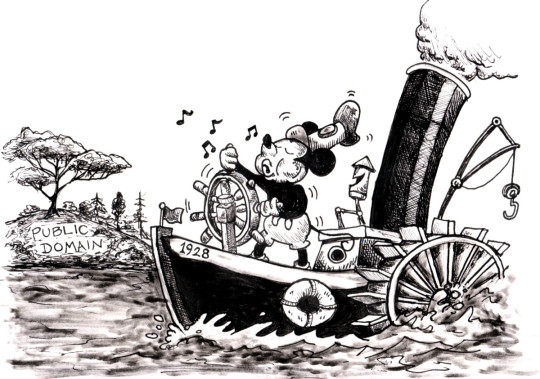
For the public domain, time stopped in 1998, when the Sonny Bono Copyright Act froze copyright expirations for 20 years. In 2019, time started again, with a massive crop of works from 1923 returning to the public domain, free for all to use and adapt:
https://web.law.duke.edu/cspd/publicdomainday/2019/
No one is better at conveying the power of the public domain than Jennifer Jenkins and James Boyle, who run the Duke Center for the Study of the Public Domain. For years leading up to 2019, the pair published an annual roundup of what we would have gotten from the public domain in a universe where the 1998 Act never passed. Since 2019, they've switched to celebrating what we're actually getting each year. Last year's was a banger:
https://pluralistic.net/2022/12/20/free-for-2023/#oy-canada
But while there's been moderate excitement at the publicdomainification of "Yes, We Have No Bananas," AA Milne's "Now We Are Six," and Sherlock Holmes, the main event that everyone's anticipated arrives on January 1, 2024, when Mickey Mouse enters the public domain.
The first appearance of Mickey Mouse was in 1928's Steamboat Willie. Disney was critical to the lobbying efforts that extended copyright in 1976 and again in 1998, so much so that the 1998 Act is sometimes called the Mickey Mouse Protection Act. Disney and its allies were so effective at securing these regulatory gifts that many people doubted that this day would ever come. Surely Disney would secure another retrospective copyright term extension before Jan 1, 2024. I had long arguments with comrades about this – people like Project Gutenberg founder Michael S Hart (RIP) were fatalistically certain the public domain would never come back.
But they were wrong. The public outrage over copyright term extensions came too late to stave off the slow-motion arson of the 1976 and 1998 Acts, but it was sufficient to keep a third extension away from the USA. Canada wasn't so lucky: Justin Trudeau let Trump bully him into taking 20 years' worth of works out of Canada's public domain in the revised NAFTA agreement, making swathes of works by living Canadian authors illegal at the stroke of a pen, in a gift to the distant descendants of long-dead foreign authors.
Now, with Mickey's liberation bare days away, there's a mounting sense of excitement and unease. Will Mickey actually be free? The answer is a resounding YES! (albeit with a few caveats). In a prelude to this year's public domain roundup, Jennifer Jenkins has published a full and delightful guide to The Mouse and IP from Jan 1 on:
https://web.law.duke.edu/cspd/mickey/
Disney loves the public domain. Its best-loved works, from The Sorcerer's Apprentice to Sleeping Beauty, Pinnocchio to The Little Mermaid, are gorgeous, thoughtful, and lively reworkings of material from the public domain. Disney loves the public domain – we just wish it would share.
Disney loves copyright's other flexibilities, too, like fair use. Walt told the papers that he took his inspiration for Steamboat Willie from Charlie Chaplin and Douglas Fairbanks, making fair use of their performances to imbue Mickey with his mischief and derring do. Disney loves fair use – we just wish it would share.
Disney loves copyright's limitations. Steamboat Willie was inspired by Buster Keaton's silent film Steamboat Bill (titles aren't copyrightable). Disney loves copyright's limitations – we just wish it would share.
As Jenkins writes, Disney's relationship to copyright is wildly contradictory. It's the poster child for the public domain's power as a source of inspiration for worthy (and profitable) new works. It's also the chief villain in the impoverishment and near-extinction of the public domain. Truly, every pirate wants to be an admiral.
Disney's reliance on – and sabotage of – the public domain is ironic. Jenkins compares it to "an oil company relying on solar power to run its rigs." Come January 1, Disney will have to share.
Now, if you've heard anything about this, you've probably been told that Mickey isn't really entering the public domain. Between trademark claims and later copyrightable elements of Mickey's design, Mickey's status will be too complex to understand. That's totally wrong.

Jenkins illustrates the relationship between these three elements in (what else) a Mickey-shaped Venn diagram. Topline: you can use all the elements of Mickey that are present in Steamboat Willie, along with some elements that were added later, provided that you make it clear that your work isn't affiliated with Disney.
Let's unpack that. The copyrightable status of a character used to be vague and complex, but several high-profile cases have brought clarity to the question. The big one is Les Klinger's case against the Arthur Conan Doyle estate over Sherlock Holmes. That case established that when a character appears in both public domain and copyrighted works, the character is in the public domain, and you are "free to copy story elements from the public domain works":
https://freesherlock.files.wordpress.com/2013/12/klinger-order-on-motion-for-summary-judgment-c.pdf
This case was appealed all the way to the Supreme Court, who declined to hear it. It's settled law.

So, which parts of Mickey aren't going into the public domain? Elements that came later: white gloves, color. But that doesn't mean you can't add different gloves, or different colorways. The idea of a eyes with pupils is not copyrightable – only the specific eyes that Disney added.
Other later elements that don't qualify for copyright: a squeaky mouse voice, being adorable, doing jaunty dances, etc. These are all generic characteristics of cartoon mice, and they're free for you to use. Jenkins is more cautious on whether you can give your Mickey red shorts. She judges that "a single, bright, primary color for an article of clothing does not meet the copyrightability threshold" but without settled law, you might wanna change the colors.
But what about trademark? For years, Disney has included a clip from Steamboat Willie at the start of each of its films. Many observers characterized this as a bid to create a de facto perpetual copyright, by making Steamboat Willie inescapably associated with products from Disney, weaving an impassable web of trademark tripwires around it.
But trademark doesn't prevent you from using Steamboat Willie. It only prevents you from misleading consumers "into thinking your work is produced or sponsored by Disney." Trademarks don't expire so long as they're in use, but uses that don't create confusion are fair game under trademark.
Copyrights and trademarks can overlap. Mickey Mouse is a copyrighted character, but he's also an indicator that a product or service is associated with Disney. While Mickey's copyright expires in a couple weeks, his trademark doesn't. What happens to an out-of-copyright work that is still a trademark?
Luckily for us, this is also a thoroughly settled case. As in, this question was resolved in a unanimous 2000 Supreme Court ruling, Dastar v. Twentieth Century Fox. A live trademark does not extend an expired copyright. As the Supremes said:
[This would] create a species of mutant copyright law that limits the public’s federal right to copy and to use expired copyrights.
This elaborates on the Ninth Circuit's 1996 Maljack Prods v Goodtimes Home Video Corp:
[Trademark][ cannot be used to circumvent copyright law. If material covered by copyright law has passed into the public domain, it cannot then be protected by the Lanham Act without rendering the Copyright Act a nullity.
Despite what you might have heard, there is no ambiguity here. Copyrights can't be extended through trademark. Period. Unanimous Supreme Court Decision. Boom. End of story. Done.
But even so, there are trademark considerations in how you use Steamboat Willie after Jan 1, but these considerations are about protecting the public, not Disney shareholders. Your uses can't be misleading. People who buy or view your Steamboat Willie media or products have to be totally clear that your work comes from you, not Disney.

Avoiding confusion will be very hard for some uses, like plush toys, or short idents at the beginning of feature films. For most uses, though, a prominent disclaimer will suffice. The copyright page for my 2003 debut novel Down and Out in the Magic Kingdom contains this disclaimer:
This novel is a work of fiction, set in an imagined future. All the characters and events portrayed in this book, including the imagined future of the Magic Kingdom, are either fictitious or are used fictitiously. The Walt Disney Company has not authorized or endorsed this novel.
https://us.macmillan.com/books/9781250196385/downandoutinthemagickingdom
Here's the Ninth Circuit again:
When a public domain work is copied, along with its title, there is little likelihood of confusion when even the most minimal steps are taken to distinguish the publisher of the original from that of the copy. The public is receiving just what it believes it is receiving—the work with which the title has become associated. The public is not only unharmed, it is unconfused.
Trademark has many exceptions. The First Amendment protects your right to use trademarks in expressive ways, for example, to recreate famous paintings with Barbie dolls:
https://www.copyright.gov/fair-use/summaries/mattel-walkingmountain-9thcir2003.pdf
And then there's "nominative use": it's not a trademark violation to use a trademark to accurately describe a trademarked thing. "We fix iPhones" is not a trademark violation. Neither is 'Works with HP printers.' This goes double for "expressive" uses of trademarks in new works of art:
https://en.wikipedia.org/wiki/Rogers_v._Grimaldi
What about "dilution"? Trademark protects a small number of superbrands from uses that "impair the distinctiveness or harm the reputation of the famous mark, even when there is no consumer confusion." Jenkins says that the Mickey silhouette and the current Mickey character designs might be entitled to protection from dilution, but Steamboat Willie doesn't make the cut.
Jenkins closes with a celebration of the public domain's ability to inspire new works, like Disney's Three Musketeers, Disney's Christmas Carol, Disney's Beauty and the Beast, Disney's Around the World in 80 Days, Disney's Alice in Wonderland, Disney's Snow White, Disney's Hunchback of Notre Dame, Disney's Sleeping Beauty, Disney's Cinderella, Disney's Little Mermaid, Disney's Pinocchio, Disney's Huck Finn, Disney's Robin Hood, and Disney's Aladdin. These are some of the best-loved films of the past century, and made Disney a leading example of what talented, creative people can do with the public domain.
As of January 1, Disney will start to be an example of what talented, creative people give back to the public domain, joining Dickens, Dumas, Carroll, Verne, de Villeneuve, the Brothers Grimm, Twain, Hugo, Perrault and Collodi.
Public domain day is 17 days away. Creators of all kinds: start your engines!

If you'd like an essay-formatted version of this post to read or share, here's a link to it on pluralistic.net, my surveillance-free, ad-free, tracker-free blog:
https://pluralistic.net/2023/12/15/mouse-liberation-front/#free-mickey

Image: Doo Lee (modified) https://web.law.duke.edu/sites/default/files/images/centers/cspd/pdd2024/mickey/Steamboat-WIllie-Enters-Public-Domain.jpeg
CC BY 4.0 https://creativecommons.org/licenses/by/4.0/deed.en
#pluralistic#copyfight#scotus#mickey mouse#public domain#ip#contract#trademark#tm#jennifer jenkins#copyright#disney#nominative use
6K notes
·
View notes
Text
With I’m Still Here,Brazilian Icon Fernanda Torres Goes Global

The Cannes-winning actor is stoking Oscar buzz for her revelatory performance in Walter Salles’s harrowing biopic.
BY DAVID CANFIELD NOVEMBER 26, 2024
It’s been nearly three months since Fernanda Torres was last home in Brazil. Over Labor Day weekend, the Rio de Janeiro native traveled to Venice for the world premiere of I’m Still Here, her first movie since the pandemic, which reunited her with Walter Salles, director of her 1996 film Foreign Land. Coming off rave reviews and a prize for best screenplay, I’m Still Here screened for a wider audience in Toronto, with Torres in tow. She then went down to New York for a month, where the movie made its US debut—and where she got to catch up on her competition: Mike Leigh’s Hard Truths (“Marianne Jean-Baptiste? It’s unbelievable”), Pedro Almodóvar’s The Room Next Door (“Wonderful”), Jacques Audiard’s Emilia Pérez (“Zoe Saldaña: She sings. She acts. Come on. It’s almost annoying. How can you be so good at so many things?”). Finally, Torres wrapped a 25-day stint in Hollywood, presenting I’m Still Here to voters for the Oscars, Golden Globes, SAG Awards, and more.
Following her first trip to the Governors Awards just over a week ago, she’s returned home—for now. But as I’m Still Here continues to screen for industry members here in Los Angeles, one senses Torres’s life on the campaign trail is just getting started. (She’s flying back to LA right after New Year’s.) Anecdotally, the film is emerging as one of the most beloved discoveries around town, a lovingly crafted and rousing portrait of Eunice Paiva (Torres), a housewife turned activist in ’70s Rio whose husband, former congressman Rubens Paiva (Selton Mello), is apprehended by the dictatorial regime taking power in their country. Torres’s quiet, elegant, powerful portrayal has earned her a spot in a stacked best-actress conversation fronted by megastars Nicole Kidman, Angelina Jolie, and Demi Moore.
Not that Torres is any slouch when it comes to fame. The 59-year-old is the daughter of iconic Brazilian actors Fernando Torres and Fernanda Montenegro, the latter of whom plays an older Eunice in I’m Still Here. At 20, Torres won best actress at the Cannes Film Festival for her spellbinding turn in the marital drama Love Me Forever or Never. She’s gone on to draw sold-out crowds onstage, including in a lauded solo show adapted from João Ubaldo Ribeiro’s novel A Casa dos Budas Ditosos; write scripts for feature films and streaming TV series; anchor hugely popular sitcoms like Slaps & Kisses; and sell more than 200,000 copies locally of her debut novel, The End.
“To be a modern artist nowadays, you have to be alive in many places in order to survive. If you keep waiting for an invitation for a film or whatever, you’ll be dead,” she says. “You have to reinvent yourself all the time…. So it’s very good to get older. That’s a very good fact of aging.”

I’m Still Here
While she was growing up, Torres’s parents rehearsed at the dining table. “I really enjoyed sitting there after school—they were doing Eugene O’Neill, Arthur Miller,” Torres says. From her early years, she felt her destiny was to be an artist, to carry on in their tradition: “Come on. My father was called Fernando. She’s called Fernanda. I’m called Fernanda. Freud should do a case about my family.”
She got her start on camera as a young teen, and by the time she turned 18, she found herself already being pulled in different directions. When Love Me Forever or Never premiered in Cannes, for instance, Torres was stuck back home. “I was the leading lady of a soap opera, and I was hating it. I was hating it with all my heart,” she says. “She cried, she was dumb—I couldn’t stand it anymore.” Rumors swirled that she was in the running to win best actress at the festival, but she couldn’t leave her day job. Sting wound up presenting the award without her in attendance. “I was so sad that I didn’t receive the award from the hands of Sting,” Torres says now. “But I received it in Brazil, so it was like the World Cup—I was walking in the streets with people screaming.”
At the same time, Brazil’s film industry was slowing down. “I thought I would do one movie after the other, [but] then cinema was over when I came back to Brazil,” Torres says. She did an acclaimed stage production of Virginia Woolf’s Orlando instead, while still dabbling in features when she could—including linking up with a then hotshot filmmaker in Salles. Foreign Land allowed Torres to shine in a searing tale of immigration and loneliness. “We were like kids. He was very fast. We did stunts together in a very old car he was driving without seat belts; the third time we did the spinning, the car almost rolled over—and then we said, ‘I think it’s fine!’” she says. “We could’ve died. It’s the kind of thing that you do when you are young.”
Salles developed a working relationship with Torres’s mother too. Generally, Torres has embraced the link to her parents, the feeling of carrying on Brazilian art. “Nowadays, in this mean world that we live in, it’s called ‘nepo babies,’” Torres says. “[But] this is such a tradition, the circus family—this is something beautiful. It is a job that you can learn by watching, by mimicking, by living in an environment. It’s like doctors. But no, nowadays they’ve decided that [we are] ‘nepo babies.’ Such a silly world.”
Onscreen over the years, Torres has come to be known for her work in comedy—specifically, broad TV comedy. In Slaps & Kisses, she played an outspoken bridal-shop employee dating a married man, amassing a significant fan base on the strength of her go-for-broke performance as a teary, sometimes rageful, often hilarious flirt. When I met Torres in Los Angeles earlier this month, she described Salles casting her in I’m Still Here as “rescuing” her from comedy—it had become all she was known for.
Over Zoom a few weeks later, she clarifies: “People thought I was a comedian because I was so popular,” she says. “Go on the internet. I mean, I’ve survived with the young generation because I became memes. My memes in Brazil were like a fever. I find memes a superior form of art. I’m very proud.” Of course, Torres also considers herself more than a meme, even if she still delights in that aspect of her career. “I like tragicomedies. Brazil is a tragicomic country. I’m a tragicomic actress.”

I’m Still Here leans toward heavy drama. It’s based on the memoir of the same name (Ainda Estou Aqui in Portuguese) by Eunice and Rubens Paiva’s son, Marcelo Rubens Paiva, but rooted in Salles’s own memories of visiting the family home when he was a teenager. The director hadn’t made a Brazilian feature in 16 years, instead helming a Francis Ford Coppola–produced On the Road adaptation as well as a documentary on filmmaker Jia Zhangke. So it’s no coincidence that I’m Still Here opens like an intimate series of home videos, personal and familial and gorgeously local. When Rubens disappears, a terrifying uncertainty settles in.
The movie was shot documentary-style, in chronological order and with a sense of familiarity between cast and crew that was blurred between takes. That allowed Torres to forge a unique connection to Eunice. The film sticks to her character’s perspective and employs meticulous naturalism; the events unfold like an all-too-realistic gut punch. “It was filmed in a very simple way, and I spent so much time under her skin that it became a second nature to me,” she says. “When I watched the movie, I was a bit in shock because it didn’t look like me.”
The movie does not jump forward in time until its final act. Mostly, it unfolds in the family home immediately after Rubens disappears, as Eunice figures out what to do—keep raising her five children, try to find her husband, learn about fighting back against the military dictatorship? “She is very intelligent, very persuasive, but she’s never pushing—she’s just like the movie,” Torres says. “The whole fact that she never cries or screams—it was a kind of emotion that I never experimented with as an actress, to restrain emotion and to feel how it grows inside you. I didn’t know if that was going to work.” To watch Torres explore that space in real time, simultaneously keying into the birth of an activist and the grief of a widow, proves profoundly moving.
Sony Classics will release I’m Still Here in January, with a short 2024 debut for US awards. It’s likely to be Brazil’s first Oscar nominee for best international feature in some 26 years, and Torres could be the second-ever Brazilian star to get an acting nomination—following her mother, who was nominated for Salles’s Central Station. The film is already a phenomenon in Brazil, having grossed $6.6 million in less than a month—a massive haul for that territory, and the biggest for a local film in several years. “It became like a national passion—people are going to the movies here like I’ve never seen before,” Torres says. Paiva’s story of persistence and resistance has resonated nationally, and Torres sees signs of that appeal extending globally.
One fan of the film, Sean Penn, told Torres at a recent CAA screening that he watched the movie immediately after Donald Trump’s reelection as president. “[He’s] very inspired by this amazing woman that nobody knew about,” Torres says of Penn. “It’s an important movie for now.” Reflecting on these dizzying last few months from back home, Torres keeps stopping to smile at the response. She’s not complaining about getting back on a plane soon. “I don’t think this will happen again in my life,” she says. “So let’s enjoy it.”
David Canfield HOLLYWOOD CORRESPONDENT David Canfield is a Hollywood correspondent at Vanity Fair, where he reports on awards season and co-hosts the Little Gold Men podcast. He joined VFfrom Entertainment Weekly, where he was the movies editor and oversaw awards coverage, and has also written for Vulture, Slate, and IndieWire. David is a National Arts & Entertainment Journalism Award finalist and GLAAD Media Award nominee, and has written cover stories on Cate Blanchett, Benedict Cumberbatch, and more. He lives in Los Angeles with his husband. Follow him on Twitter. SEE MORE BY DAVID CANFIELD »
5 notes
·
View notes
Text

The 1,289 movies I saw in 2024...
This is my fourth 'End of Year' recap. In January 2021, during the Covid lock-down, I began logging the many films that I watch every day, just to keep track. In the beginning I jotted a line or two about each, only to create a record. But then I started adding longer notes and more elaborate impressions, and before I knew it, I've got a 'Film Project' on my hands.
The obsessive project mushroomed. In the course of these four years, I watched and reviewed a total of 4,126 movies; 885 in 2021, 954 in 2022, 998 in 2023, and a ridiculous number of 1,289 movies this last year.
And it seems that I'm just getting started.
As I wrote before, I owe an apology to nobody for my indulgence. I derive great pleasure from discovering daily the best movies ever made, and I enjoy even more the process of thinking about them and coming up with my own specific takes, if I can. As an un-accomplished 'Creator', composing short reviews fills me with just the right amount of self-fulfillment. The fact that I am blessed with the physical and financial ability to enjoy this type of existence right now, at the end of my own life and while civilization collapses all around us, is not lost on me either.
The project, like the many others I created before it, is purely personal, and is a strict 'labor of love'. Watching a movie today is an individual experience [Except of one visit, I haven't been to a theater in many years], and maintaining this blog (which hardly anybody visits), is done as a form of mental masturbation; I do it every day because I like it a lot, and because it doesn't hurt anybody. I described my background before, so there's no need to repeat it here.
So here are some generalities, with a dozen 'Best-Of' samples below.
I've made a concerted effort to watch more films helmed by women directors - 215 in all (but only 16% of the total). Next year I will increase that number.
I like good documentaries, and of the 1,289 movies, 170 were documentaries. However, most of them were not that great. Surprisingly, only 99 were repeat films that I had watched before – it felt as if the number would be higher. I also started watching many more short films (5 to 40 minutes), and I plan focusing even more on short films in the coming year.
As I'm moving away from Hollywood-type blockbuster fair, I saw 737 “Foreign” films (read: Not American) which were 57% of the total. Next year I will be sure to increase that ratio too.
Here is the break-down by country:
From the UK (108)
From France (106)
From Canada (44)
From Japan (40)
From Denmark (25)
From "Czechoslovakia" (24)
From Germany (21)
From Sweden (20)
From Italy & "Russia" (18 each)
From Israel & Poland (17 each)
From Brazil (16)
From Australia, Iran & Ireland (13 each)
From Iceland, Korea & Spain (12 each)
From Hungary (11)
From Turkey (10)
The rest were films from China, Romania, The Netherlands, Argentina, India, Yugoslavia, Belgium, Finland, Latvia, Mexico, Chile, Croatia, Norway, Austria, Cuba, Egypt, Greece, Morocco, Palestine, Scotland, Switzerland, Hong Kong, New Zealand, Nigeria, Slovenia, Bulgaria, Georgia, Haiti, Lebanon, Philippines, Saudi Arabia, Singapore, Afghanistan, Armenia, Colombia, Cyprus, Ethiopia, Indonesia, Jordan, Paraguay, Portugal, Senegal, Sudan, Taiwan, Thailand, Tunisia and Wales. [But unlike 2023, no films in Babylonian this year...]
Many of these 1,293 movies were terrible. But only 23 of them I simply couldn't finish. They included: Otto Preminger's 'Exodus', Troma Studio's 'Poultrygeist', Polanski's 1970 'A day at the beach', The Japanese 'Patisserie Coin de rue', Bob Fosse 'All that Jazz', M. Night Shyamalan 'The happening', Gene Hackman's 'Heartbreakers', Elaine May 'A new leaf', Etc. Many of the others were boring, tedious, stupid. YMMV.
Next year I will also start keeping track of the genres, which I haven't done up to now. I may try new things, but there are some popular genres I generally stir away from: Superheros, horror, franchise, fantasy. There were six A.I.-generated films that I saw this year. I predict that in 2025 we will have the first 'good' A.I. features.
I wish I had signed up to Letterboxd at the start. It would have made sorting the list so much easier. But I've been dropping out of all social media (reddit and tumblr are the only ones still standing), and I don't plan on starting on a new platform.
I only felt the urge to "rate" 40% of the movies I saw (527), and of the ones that I did rate, there were 18 which I designated “Best”, and 78 to which I gave the 10/10 score. 'Best' for me usually meant that it offered a 'very' strong emotional reaction.
40 years ago I studied film at Copenhagen University, but it's only during these last few years that I've become pretty knowledgeable about the overall history of the cinema. It is therefore my favorite experience today to come across a movie I never even heard of, maybe from a different time and place, which knocks me completely over.
And so, here are a few of the less obvious gems which I enjoyed the most this year. Many more on the blog. Check them all out if you want.
The films of Icelandic Hlynur Pálmason (all but 'Winter brothers'). My favorite was 'White, white day', a masterful feat of slow film making, with unusual choices in its subtle direction. A policeman grieves for his wife who died in a car accident. The man renovates a house, takes care of his cute granddaughter, and then, (like ‘The Descendants’), he discovers that before she died, his beloved wife had an affair with some guy. A stunning story of heartbreak, resignation and acceptance. The Trailer.
Nuri Bilge Ceylan 8 films (I still haven't seen his 'Casaba' and 'Clouds of May'). My favorite of his: 'About Dry Grasses' which plays for over 3 hours in the desolate, snow-covered mountains of Eastern Anatolia. Like Mads Mikkelsen in 'The Hunt’, a teacher in a small village is being falsely accused of improper behavior toward a 14-year-old girl. But the slow and meandering story embraces other themes as well, of longing, of truth seeking, of weariness, complacency and contempt. With a delusional, self centered man and the two females he misunderstands and maligns. It includes one shocking 'break the 4th wall’ moment (at 2:05:00) which illustrates that nothing we think and believe in is true. The trailer.
'A brand new life' (2009), a heart-breaking Korean story, based on the director’s personal life. A sweet 9-year-old girl is abandoned by her father, who one day and without any warning drops her off at a Catholic orphanage in the countryside and leaves. Life is suddenly too painful for her. With the cutest little girl, who has to deal with life’s harshest lessons. A relatable debut feature, it uses the simplest and purest film language. It's similar to other tragic stories about innocence lost; Carla Simón’s ‘Summer 1993’, the French film 'Ponette’, and the Irish 'The Quiet Girl’ from last year, all with the same kind spirit and sad understatements. The trailer.
'The Last Repair Shop', winner of last year's Oscar for Best Documentary Short. A quiet story about a shop that maintains and repairs the 80,000 musical instruments used by students of the Los Angeles school district. It’s about mending broken things so they can be whole again, performed by people who were also broken, but are now whole. Similar to and even better than the 2017 Oscar nominee 'Joe’s Violin'.
'Ága', my first Bulgarian film, but it plays somewhere in Yakutsk, south of the Russian arctic circle. An isolated old Inuit couple lives alone in a yurt on the tundra. Slow and spiritual, their lives unfold in the most unobtrusive way, it feels like a documentary. But the simplicity is deceiving, this is film-making of the highest grade, and once Mahler 5th is introduced on a small transistor radio, it’s transcendental. The emptiness touched me deeply. (I should watch it again!). The trailer.
'Symphony No. 42' by Hungarian animator Réka Bucsi. It consists of 47 short & whimsical vignettes, without any rhyme or rhythm; A farmer fills a cow with milk until it overflows, a zoo elephant draws a “Help me” sign on a canvas, a UFO sucks all the fish from the ocean, wolves party hard to 'La Bamba’, an angry man throws a pie at a penguin, two cowboys holding blue balloons watch a tumbleweed rolls by, a big naked woman cuddle with a seal, etc. etc. Bucsi made it before Don Hertzfeldt’s 'World of tomorrow’ and even before 'Echo', my favorite Rúnar Rúnarsson’s. 10 perfect minutes of surrealist chaos.
'Shirkers', a 2018 documentary. Sandi Tan was an avant-garde teenage punker when she set out to make Singapore’s first New Wave road movie in 1992, together with 2 female friends and a middle aged mentor. But when the shooting was over, this 'mentor’ collected the 72 canisters of completed film as well as all supportive materials, and disappeared. For 20 years, Sandi and friends could not figure out what had happened, and eventually gave up on their groundbreaking work. This documentary pieces together the mystery, telling about the process of making the original movie, the consequences of losing - and finding it again - after all this time. Absolutely tremendous. The trailer.
'Dwelling in the Fuchun Mountains' is young Chinese prodigy Gu Xiaogang's debut feature. A slow epic saga (2.5 long hours) of a large family struggling during four seasons through life’s ups and down in this provincial city. It’s a metaphor for a classic scroll painting from the 14 century, and it is apparently only the first chapter in an upcoming trilogy. A stupendous, slow-moving masterpiece told in a magnificent style, and half a dozen transcendental set pieces. The trailer.
The short jazzy documentaries of Dutch Bert Haanstra, especially 'Glass' (1958), the first Oscar win for The Netherlands, and 'Zoo', which was made 3 years later.
'Apollo 11', a documentary by Todd Douglas Miller. An exhilarating re-telling of the moon landing from 2019. Perfectly crisp and emotionally laid out, without any bullshit narration, talking heads interviews or irritating recreations. Just jaw-dropping photography which puts you in the middle of the action. The trailer.
I’ve always loved Buñuel’s last 3 films, maybe because they were so easy to watch. The fire and brimstone of his youth were distilled into accessible, vivid tableaux. Re-watching his 'The Discreet Charm of the Bourgeoisie', (or “Six friends and the impossible dinner”) was just delightful: You nearly feel sorry for these poor 1-procenters, who can’t find a decent place to eat in. Their illogical dreams dredge out their childhood traumas, and there’s no explanations to anything that happens. It was the New 4K trailer which drew me back.
The magical work of Australian stop-motion animator Adam Elliot. Especially, 'Mary and Max'. A weirdly adult 'Wallace and Gromit', a dark and tragic clay figure story, voiced by Philip Seymour Hoffman and Toni Collette. Two damaged and unfortunate souls connect by becoming pen pals; A lonely Australian 8-year-old girl with an ugly birthmark on her forehead, and an obese Jewish New Yorker with Asperger’s. It encompasses 20 years of outlandish long-distance emotions which ends with the acknowledgment of friendship. The trailer.
'Pirosmani' (1969), my first Georgian masterpiece which was not made by Sergei Parajanov. It’s an awe-inspiring biography of Nikolai Pirosmanashvíli. He was a self-taught, naïve Georgian painter who lived during Vincent van Gogh’s time, and like him, died destitute and unappreciated by his piers, only to find prominence decades after his death. (Japanese Trailer here.) It’s an absorbing and visually-stunning film, composed of rural tableaux and primitive folk setting, a mixture of Henri Rousseau, Gauguin, Édouard Manet, Bruegel and Jodorowsky. A sad, slow and formal composition, full of sublime pathos and simplicity.
'For the hungry boy' (2018), my all-time favorite Paul Thomas Anderson work, even more than his “Phantom Thread”, out of which these discarded shots were collected. Vicki Krieps is a major crush. The score is Jonny Greenwood’s “House of Woodcock” from the movie. I've seen it at least 15 times since October.
'Nostalgia for the light' (2010), my first film by Chilean Patricio Guzmán. His life-long work had been occupied with the Chilean coup d'état and the collective scars suffered by the people of Chile to this day. This beautiful documentary starts with examining the gigantic telescopic installations at the Atacama desert, used by astronomers to discover the origins of the cosmos. He then segues into the story the 60,000 'disappeared’, who were imprisoned in large concentration camps in the same area, and then murdered without a trace. A group of wives and sisters have been roving for decades now the same barren area, searching for bone fragments of their loved one. So both archaeologists and astronomers are looking for clues about the past. The trailer.
A woman interviewed in one continued shot: A small 1993 French masterpiece 'Emilie Muller'. A young woman arrives for her first ever audition where she’s asked to show the contents of her handbag. As soon as I finished watching it, I had to watch it again, and then a third time.
“Wow! So, are there any last words you would like to say, about this whole thing?” Not really.
Here is a Google spreadsheet with the output of all 4 years.
Please become one of the few regular people who visit this blog. I post 20-30 new film reviews every Monday morning, Copenhagen time. Bookmark and interact.
Arigato gozaimasu.
6 notes
·
View notes
Note
ayo since youve been to seoul, can u recommend anywhere to visit? i went last year and im going again in a few months but besides myeongdong and the typical touristy places i didnt have time to go anywhere else
yooooh so in 2023 I was working twice in Seoul -
one time as a sound tech for a artist friend of mine who had their solo exhibit in Gyeongbokgung in the north of the city
and half a year later as a sound artist with a artist collective exhibiting and performing in Munjeong-dong in the southern outskirts of Seoul.
I entirely fuck with nature and tried to visit as many gardens, public parks, botanical gardens and mountain parks as I could. You cannot go wrong with any of those.
Aside from that I was really interested in art and artistic crafts - thanks to some korean friends who sent me instagram accounts of local galleries and events.
I was lucky to find some places showing sound and experimental art in Euljiro-Dong. This is a place that is RAPIDLY changing. The district is special because of its huge spectrum of artistic and technical manual craftsmanship. In the 6 months between my two visits an entire street block had been demolished and replaced by high rise buildings. The city changes crazy fast!
I also LOVE the Cheonggyecheon River stream - the ancient former city border used to have a multileveled highway constructed above it but since 20 years now flows over 10 km trough Seouls City center as a renatured river ecosystem.
Following the stream is a super lovely way to explore the city and also pass the famous textile and fabric district of Dongdaemun.
If you are interested in anything fashion or textile related, this is the place to be and you could honestly get lost in the universe of one of the building complexes.
I experienced the Itaewon district as one of the most diverse places I have ever been to - where else in the world can u find a central mosque down the street of the so called "homohill" of the gay- and transbars, the Nigerian community next to the Vietnamese Community and an elementary school in the middle of the most vibrant night life full of neon crosses and kebab stores in the HEART of Seoul.
I also recommend trying out any Jjimjilbang / Sauna you can find if you can go with a local. It is the most chill experience when someone first shows u around and then u can basically add 5 years to your life.
The Hongdae 24 H Sauna(the one skz filmed at) is actually super accessible to foreigners and a good place if its your first time at a jjimjilbang.
Every time I went to Korea I came back healthier and I am chronically ill - the saunas and nutrition was just on point and affordable.
Lastly, I recommend the Seoul National Museum. It's free entry and you legit can spend an ENTIRE DAY in that spaceship of a building. Many amazing topics and exhibits so explore also just a fun place. There r some stray cats living in the park in front of the complex and I recommend them too.
skz is actually not super represented in public. only by chance I saw a skz hilfiger ad billboard in Itaewon and a Lotte Duty Free ad at an airport. I saw way more bts, nct and many girl groups represented in public.
I did go up to Namsan Tower because I am insufferable and wanted to check out how gay it would be to kidnap your best bro up there for surprise dinner and take photos with a giant heart statue on a platform that is entirely dedicated for couples and has a specific proposal spot. yea.
It's getting long, so anyway, I recommend following your special interest and hanging out with people who live there.
have fun and eat a lot of good food!
6 notes
·
View notes
Text
Arrival!


Writing to you this morning from our hotel breakfast! Just wanted to fill in everyone about the rest of our trip before we start our first full day. I doubt we'll be able to post EVERY SINGLE DAY WE'RE HERE but we're definitely gonna try and keep it frequent enough to be interesting!
From our last post, we were heading from Baltimore to Toronto, which was a very quick hour and a half-ish flight. From Toronto, we headed straight to our gate to which started boarding shortly thereafter, so it was a pretty quick turn around. It was almost kind of a shame because airport was actually kinda pretty, and I wouldn't have hated a few extra minutes to look around at all the really lavishly decorated restaurants and stuff.


Then came the 14 hour flight. It IS a very long time, don't get me wrong, and by the end my back was VERY achy and my legs definitely craved stretching but also they keep the windows closed and the lights low for most of the trip so you honestly kind of lose track of how long you've been on there.


Charles and I both watched some movies on the flight; we started the first two episodes of Severance (which was also provided on the flight and I've been curious about for a while anyway -- anyone else here seen it?) and played games on our Switches. I also read a lot; I loaded my e-reader up before we left. In a weird way it was kind of nice to have such a long, uninterrupted time where there was nothing to do but leisure activities even if you're doing them in a mostly uncomfortable way --I think Charles and I (Charles especially) struggle with justifying how we spend our free time, always feeling like there has to be something else we can be working on or doing, but it's kind of a bad habit and terrible mental state to always be in, so we're working on it. Unfortunately, neither of us managed to get much sleep on the flight despite our best efforts, I think I managed maybe 20 minutes total?? So it wasn't super restful for sure.
Thankfully, our flight was kinda ahead of schedule, and we ended up landing around 5:00 PM / 17:00 which is like....3:00 AM for those of you in the Eastern US timezone! We're 12 hours ahead of y'all, so when I'm writing this, I'm writing to you from the future!!!

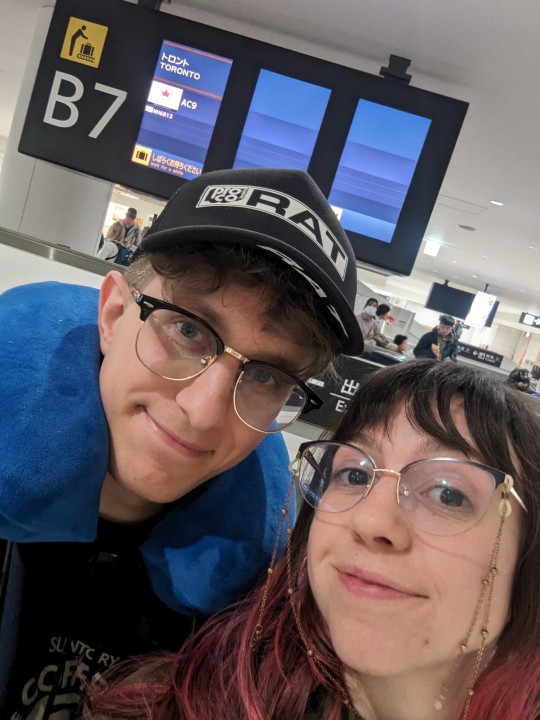
After getting through customs and immigration, baggage, etc. we were stopped by a news crew from a show called Why Did You Come To Japan? They seem to stop tourists at the airport pretty regularly, and we ended up talking to them for a while. Charles said that as someone who used to be a camera guy himself, he always tries to stop for folks filming stuff like that, because he knows how hard it can be to get people to talk to you and work with you. They were very interested in the fact it was our honeymoon, and that we got engaged here, and even more interested that we were really into Oishinbo, which is a food manga from the 80s/90s. It's not super popular in the US although personally I love & recommend it, and I kinda get the impression from the crew we spoke to that it's a classic but kinda old fashioned here. They said in all their years of doing these interviews, it was their first time having a foreigner mention it. They gave us a card and a slip of paper and asked us to contact them again, because they may be interested in meeting up with us again later in our trip to film more for the show (!?) so we'll see how that pans out I guess!


Speaking of, after we finally left the airport, we took the Skyliner train to Nippori, and then transferred to a JR Line train to get us to Shinjuku station. We've stayed in Shinjuku for at least part or all of our trips in the past, and it kind of feels like a home base for us now. We usually stay in or around the Kabukicho area, which is known as an entertainment district with lots of nightlife. If you want brilliantly lit signs and that crowded cyberpunk-y look, Kabukicho is a great place to be!

NOT THAT IT SUPER MATTERS, BUT the card in the photo, with Hello kitty and other Sanrio characters on it, is a Pasmo card, we each got one. Basically it's a little card that you can add money to, and you can use it to pay fare on most trains and buses, as well as lots of vending machines and stuff like that. You can top it off as you go as well.


We checked in to our hotel, the Shinjuku Gracery, and IMMEDIATELY needed to stretch out on the bed and shower the sweaty airport off of us, haha. The Gracery is built on top of a Toho Cinema movie theater, and the whole hotel has a very classy Godzilla theme to it. There's a to-scale Godzilla head built on top of part of the building, looking like he's about to demolish it, and he roars and blows steam out of his mouth, haha. To be honest, a night in the Gracery is one of our "we're on our honeymoon, we deserve this!" splurges -- it's one of the more expensive parts of our trip, given the rest of the time we'll be staying in smaller hotels and airbnbs and the like. We dished out a little extra cash to stay in what they call a Godzilla view room, where you can see the head of Godzilla that is mounted to the roof of the hotel from your room! Totally cool. I had to include specifically a picture of the shower, because I loooove these big hotel showers!







(sadly the filter for this exhibit not only doesn't fit my phone screen but also insanely reduced the image quality LOL)
We took a rest, then headed out to get a bite to eat. We hit up a ramen shop we'd been to in the past, and spent a while walking around the Kabukicho area, including the micro-bar district, Golden Gai. It was interesting to see what's changed and what hasn't since we were here last; for example, they were in the process of demolishing a VR arcade when we were last here, and now there's an ENORMOUS, lux-looking hotel in its place!




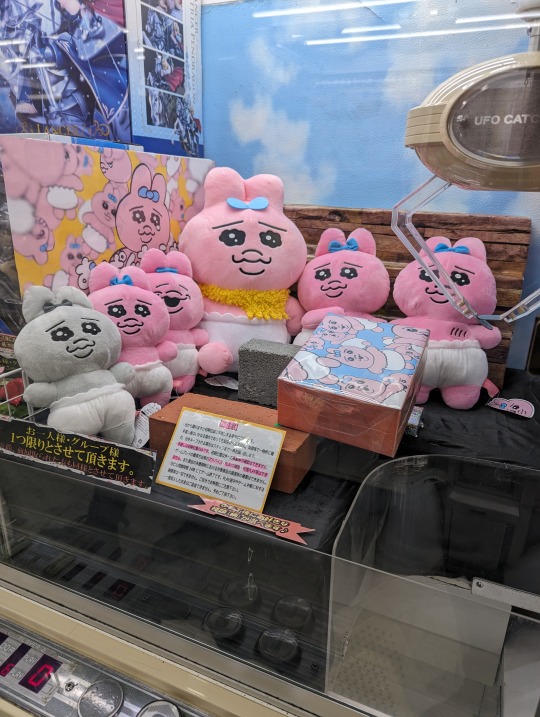
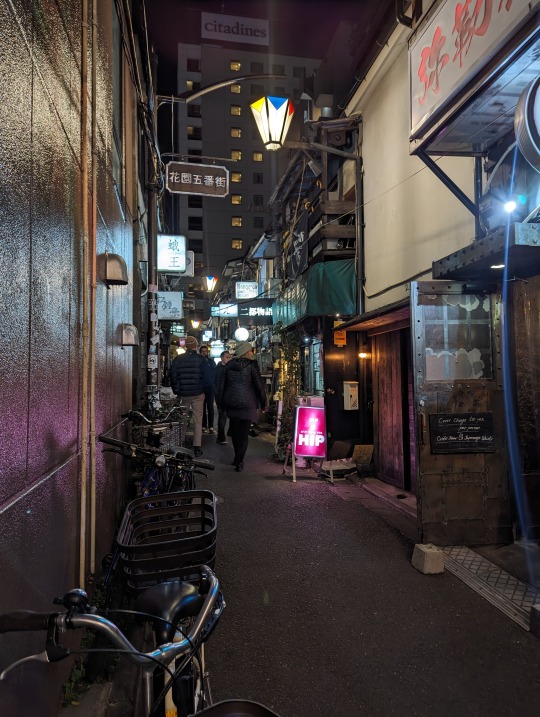
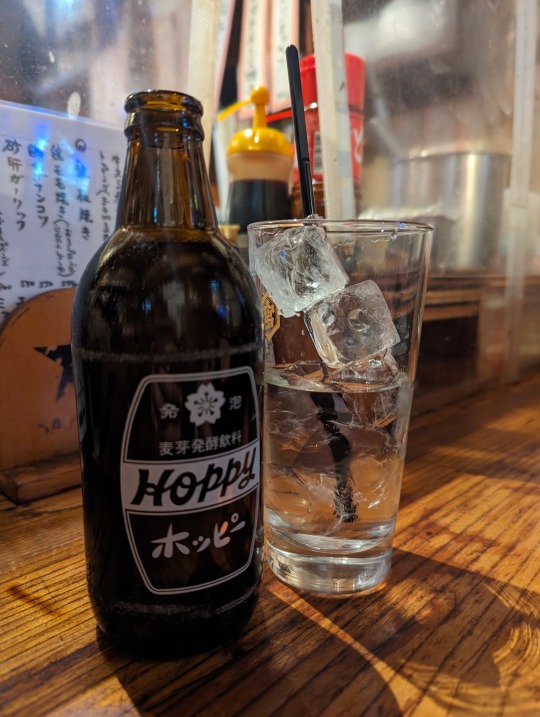
We ended up in the unfortunate position of feeling physically very tired but mentally pretty awake, and even though we spent time in our hotel room soaking in the bath, it was probably 1 AM our time before we actually fell asleep, meaning we were up for like....32 hours straight, I think?
Today, our plan is to check out a few shops in the area around Kabukicho, and a little later we'll be checking out and moving on to Akihabara, where our next hotel is. It's well known for being crammed with electronics and used and new like....nerd stuff, and is pretty close to a district jam packed with guitar shops, so we'll have a pretty full day! Stay tuned I suppose!!
Til next time!
4 notes
·
View notes
Text
'Warner Bros Japan has criticised what it called “extremely regrettable” Barbenheimer tweets shared by their US counterparts.
It joins a growing backlash in Japan against the conflation of Greta Gerwig’s playfully marketed film with Oppenheimer, a biopic of the scientist behind the atomic bombs dropped on Hiroshima and Nagasaki.
A translation of the statement, which was posted on Japan’s Twitter account for the Barbie film, reads: “Because the movies Barbie and Oppenheimer were both released in the US on 21 July, there is currently a movement driven by overseas fans to watch them together (#Barbenheimer), but this is not an official movement. We find the reaction to this fan-driven movement from the official US account for the movie Barbie to be extremely regrettable. We take this very seriously and are asking the US head office to take appropriate action. We apologise to those offended by these inconsiderate actions.”
The release of Barbie and Oppenheimer resulted in millions around the world seeing the two vastly different blockbusters as an ironic double bill dubbed “Barbenheimer”.
On social media, users have been sharing memes and art combining the fun pink imagery of Barbie with mushroom clouds and fiery explosions in Oppenheimer.
But the hashtag #NoBarbenheimer has been trending in Japan in the last week, with some social media users criticising the concept of Barbenheimer as trivialising nuclear weapons and the impact the bombings had on Japan, the only country to experience a nuclear attack. One #nobarbenheimer post, viewed 7m times, reads: “The official Barbie movie account is completely on board with the atomic bomb and mushroom cloud memes, so Barbie is a no-go as well.”
Warner Bros Japan’s statement came after the official US Twitter account for Barbie, a Warner Bros film, reacted positively to several Barbenheimer images shared by fans, including a fan-made poster depicting Oppenheimer actor Cillian Murphy carrying Barbie star Margot Robbie in front of a backdrop of flames. In response, the @barbiethemovie account wrote: “It’s going to be a summer to remember.”
It's going to be a summer to remember 😘💕
— Barbie Movie (@barbiethemovie) July 21, 2023
Twitter later added a community note to the post highlighting the historical context of the image: “At 8:15 a.m. on August 6, 1945 (Showa 20), an atomic bomb was dropped on Hiroshima for the first time in human history. The particular nature of the damage caused by the atomic bombs is that mass destruction and mass murder occurred instantaneously and indiscriminately.”
Barbie is due to be released in Japan in August but Toho-Towa, Japan’s largest distributor of Hollywood films, has yet to announce a release date for Oppenheimer. Despite the sensitive subject matter, the country often shows foreign films depicting the events of the second world war without backlash. But Nolan’s film has been criticised by some for not showing the extent of the devastation wrought on Hiroshima and Nagasaki, where it is estimated up to 220,000 people died in the bombings and their aftermath.
Barbie has so far made $775m globally and is already the third best-performing film of the year, while Oppenheimer has made $400m, already more than Nolan’s previous film, Tenet.
Warner Bros in the US has declined to comment.'
#Warner Bros#Barbie#Oppenheimer#Tenet#Christopher Nolan#Greta Gerwig#Barbenheimer#Twitter#Cillian Murphy#Margot Robbie
2 notes
·
View notes
Text
yapping time!!
1. coffee mugs, teacups, wine glasses, water bottles, or soda cans?
coffee mugs all the way
2. chocolate bars or lollipops?
chocolate bars, I hate lollipops I love chocolate
3. bubblegum or cotton candy?
bubblegum
4. how did your elementary school teachers describe you?
loud. very very loud. lots of personality. (I was one of those kids who was convinced she was a grown adult)
5. do you prefer to drink soda from soda cans, soda bottles, plastic cups or glass cups?
can
6. pastel, boho, tomboy, preppy, goth, grunge, formal or sportswear?
grunge, i don't think i have a specific aesthetic i just kinda wear what i think looks cool, its just that most of the time what looks cool is black clothes
7. earbuds or headphones?
headphones, earbuds give me a headache
8. movies or tv shows?
tv shows, not the biggest film connoisseur
9. favorite smell in the summer?
I spend my more memorable summers in turkey so simit vendors next to the Mediterranean Sea, also more recently burnt popcorn
10. game you were best at in p.e.?
I was really good at solo badminton if that makes sense, not much else, not excited to have to take pe again
11. what you have for breakfast on an average day?
toast. I love toast
12. name of your favorite playlist?
oh all of my rtc characters playlists, rn it’s “oceans gonna take you down // ocean oconnell rosenberg - rtc” and “like a lamb to the slaughter // penny lamb - rtc/legoland”, also “don't you worry about your curly hair” im very emotionally attached to
13. lanyard or key ring?
lanyard, I lose stuff too easily
14. favorite non-chocolate candy?
I can get behind anything sour
15. favorite book you read as a school assignment?
to kill a mockingbird :3
16. most comfortable position to sit in?
17. most frequently worn pair of shoes?
my pair of tennis shoes of the year
18. ideal weather?
RAIN GOD PLEASE I WANT RAIN
19. sleeping position?
ok the long side of my bed is up against a wall so there’s this perfect corner that I can fit my entire front body body into and it’s the comfiest thing ever
20. preferred place to write (i.e., in a note book, on your laptop, sketchpad, post-it notes, etc.)?
notes app but using the draw function or notebook, i like writing things
21. obsession from childhood?
I’ve retained a good amount of Greek mythology knowledge from 4-7th grade
22. role model?
it’s so cringe but basically all the cyclone actors that regularly interact w me i love all of them w all my heart
23. strange habits?
I meow a lot. but like. just the word meow. that might just be a stimming thing idk. idk a lot of things.
24. favorite crystal?
any one w pretty colors, I’m a little crow at heart
25. first song you remember hearing?
hello by adelle
26. favorite activity to do in warm weather?
stay home. its never just warm in az, always boiling
27. favorite activity to do in cold weather?
again, its never cold, just a little cool. so hanging out w friends :3
28. five songs to describe you?
Letter to my 13 year old self (i too have curly hair and a foreign name and wish to be a star), pink pony club, the prophecy, the grudge, youre gonna go far
29. best way to bond with you?
ASK ME QUESTIONS! MAKE ME TAKE STUPID ONLINE PERSONALITY QUIZZES! LET ME INFODUMP!
30. places that you find sacred?
the theater, I LOVE the theater
31. what outfit do you wear to kick ass and take names?
tank top, leather jacket, mini skirt, bandana, sick ass earrings
33. most used phrase in your phone?
btw
34. advertisements you have stuck in your head?
ay. gaz. duh duh duh!
35. average time you fall asleep?
12ish
36. what is the first meme you remember ever seeing?
vines compilations
37. suitcase or duffel bag?
dufflebag
38. lemonade or tea?
lemonade. lemonsssss……..
39. lemon cake or lemon meringue pie?
lemon cake
40. weirdest thing to ever happen at your school?
kid dressed up as jesus went around dapping up 5th graders
41. last person you texted?
@wa3v3y
42. jacket pockets or pants pockets?
jacket pocket
43. hoodie, leather jacket, cardigan, jean jacket or bomber jacket?
leather jacket
44. favorite scent for soap?
rose
45. which genre: sci-fi, fantasy or superhero?
fantasy
46. most comfortable outfit to sleep in?
my moms childhood clothes I stole
47. favorite type of cheese?
I hate cheese, if I have to pick, mozzarella
48. if you were a fruit, what kind would you be?
vişne :3
49. what saying or quote do you live by?
fuck it, we ball
51. current stresses?
school soon…………
52. favorite font?
fonts are a pain
53. what is the current state of your hands?
long black nails idk how else to explain it I like my hands
55. favorite fairy tale?
NASRETIN HOCA
56. favorite tradition?
I make chocolate pudding every new years, thats very fun i think, i also just like chocolate pudding
57. the three biggest struggles you’ve overcome?
November 2022, June 2023, September 2023
58. four talents you’re proud of having?
I’m really flexible despite not having much visible muscle, I have a really good semi-short term memory, and I can recite the entire script of ride the cyclone word for word
59. if you were a video game character, what would your catchphrase be?
I should’ve stayed home …
60. if you were a character in an anime, what kind of anime would you want it to be?
magical girl, I really wanna be a magical girl
61. favorite line you heard from a book/movie/tv show/etc.?
“I would gladly take my 17 years over nothing”
62. seven characters you relate to?
every cyclone character (this counts as 3), amity blight, lisa frankenstein, beth march, christine canigula
64. favorite website from your childhood?
friv 2016, I was SUCH a flash game girl
65. any permanent scars?
acne scars, don’t pick at your skin kids
66. favorite flower(s)?
call me basic but I really do love roses, and forget me nots! I love forget me nots!!
67. good luck charms?
not a charm but I always re-paint my nails when I REALLY need something to go well
69. a fun fact that you don’t know how you learned?
your skin doesn’t actually have sensors for “wet”, your brain uses surrounding context clues to figure out what actually feels wet
70. left or right handed?
right, I do use my left for basically everything else though
71. least favorite pattern?
fake paint
72. worst subject?
chemistry. it’s not even hard I just don’t listen in class
74. at what pain level out of ten (1 through 10) do you have to be at before you take an advil or ibuprofen?
like a 7
75. when did you lose your first tooth?
like 4 or 5, i was very early to everything
76. what’s your favorite potato food (i.e. tater tots, baked potatoes, fries, chips, etc.)?
in n out french fries
78. coffee from a gas station or sushi from a grocery store?
gas station coffee, coffee is coffee
79. which looks better, your school id photo or your driver’s license photo?
don’t have a drivers license but my school id is Pretty Damn Bad
80. earth tones or jewel tones?
earth tones, I love me browns and blacks and greens
81. fireflies or lightning bugs?
fireflies
82. pc or console?
PC PC PC I HATE CONSOLE PC AND ALWAYS PC
83. writing or drawing?
writing, my ability to draw is far too inconsistent
84. podcasts or talk radio?
podcasts
84. barbie or polly pocket?
Barbie, i have 2 sitting in my closet rn
85. fairy tales or mythology?
mythology
86. cookies or cupcakes?
Cookies! I make some banger chocolate chip cookies
87. your greatest fear?
everyone love leaving me, and death, isn't that everyones
88. your greatest wish?
come out wout anyone caring
89. who would you put before everyone else?
@wa3v3y hi tagged you twice. love you.
91. boxes or bags?
bags
92. lamps, overhead lights, sunlight or fairy lights?
lamp, dim enough for ambience, bright enough to comfortably see
93. nicknames?
hate them, hate them so bad
94. favorite season?
autumn! ultimate weirdgirl season!!!
95. favorite app on your phone?
tumblr, hi guys
96. desktop background?
trinity ride the cyclone!!!!
97. how many phone numbers do you have memorized?
one… my moms….
98. favorite historical era?
tudor dynasty!
weird asks that say a lot
in
1. coffee mugs, teacups, wine glasses, water bottles, or soda cans?
2. chocolate bars or lollipops?
3. bubblegum or cotton candy?
4. how did your elementary school teachers describe you?
5. do you prefer to drink soda from soda cans, soda bottles, plastic cups or glass cups?
6. pastel, boho, tomboy, preppy, goth, grunge, formal or sportswear?
7. earbuds or headphones?
8. movies or tv shows?
9. favorite smell in the summer?
10. game you were best at in p.e.?
11. what you have for breakfast on an average day?
12. name of your favorite playlist?
13. lanyard or key ring?
14. favorite non-chocolate candy?
15. favorite book you read as a school assignment?
16. most comfortable position to sit in?
17. most frequently worn pair of shoes?
18. ideal weather?
19. sleeping position?
20. preferred place to write (i.e., in a note book, on your laptop, sketchpad, post-it notes, etc.)?
21. obsession from childhood?
22. role model?
23. strange habits?
24. favorite crystal?
25. first song you remember hearing?
26. favorite activity to do in warm weather?
27. favorite activity to do in cold weather?
28. five songs to describe you?
29. best way to bond with you?
30. places that you find sacred?
31. what outfit do you wear to kick ass and take names?
32. top five favorite vines?
33. most used phrase in your phone?
34. advertisements you have stuck in your head?
35. average time you fall asleep?
36. what is the first meme you remember ever seeing?
37. suitcase or duffel bag?
38. lemonade or tea?
39. lemon cake or lemon meringue pie?
40. weirdest thing to ever happen at your school?
41. last person you texted?
42. jacket pockets or pants pockets?
43. hoodie, leather jacket, cardigan, jean jacket or bomber jacket?
44. favorite scent for soap?
45. which genre: sci-fi, fantasy or superhero?
46. most comfortable outfit to sleep in?
47. favorite type of cheese?
48. if you were a fruit, what kind would you be?
49. what saying or quote do you live by?
50. what made you laugh the hardest you ever have?
51. current stresses?
52. favorite font?
53. what is the current state of your hands?
54. what did you learn from your first job?
55. favorite fairy tale?
56. favorite tradition?
57. the three biggest struggles you’ve overcome?
58. four talents you’re proud of having?
59. if you were a video game character, what would your catchphrase be?
60. if you were a character in an anime, what kind of anime would you want it to be?
61. favorite line you heard from a book/movie/tv show/etc.?
62. seven characters you relate to?
63. five songs that would play in your club?
64. favorite website from your childhood?
65. any permanent scars?
66. favorite flower(s)?
67. good luck charms?
68. worst flavor of any food or drink you’ve ever tried?
69. a fun fact that you don’t know how you learned?
70. left or right handed?
71. least favorite pattern?
72. worst subject?
73. favorite weird flavor combo?
74. at what pain level out of ten (1 through 10) do you have to be at before you take an advil or ibuprofen?
75. when did you lose your first tooth?
76. what’s your favorite potato food (i.e. tater tots, baked potatoes, fries, chips, etc.)?
77. best plant to grow on a windowsill?
78. coffee from a gas station or sushi from a grocery store?
79. which looks better, your school id photo or your driver’s license photo?
80. earth tones or jewel tones?
81. fireflies or lightning bugs?
82. pc or console?
83. writing or drawing?
84. podcasts or talk radio?
84. barbie or polly pocket?
85. fairy tales or mythology?
86. cookies or cupcakes?
87. your greatest fear?
88. your greatest wish?
89. who would you put before everyone else?
90. luckiest mistake?
91. boxes or bags?
92. lamps, overhead lights, sunlight or fairy lights?
93. nicknames?
94. favorite season?
95. favorite app on your phone?
96. desktop background?
97. how many phone numbers do you have memorized?
98. favorite historical era?
213K notes
·
View notes
Photo

Over the past few years, U.S. television fans have "overcome the one-inch barrier of subtitles" and discovered the wide world of international TV, thanks in no small part to Netflix. According to the streaming giant, more and more U.S. subscribers are watching foreign series each year, with Korean, Spanish, and Japanese shows being the most popular. 2024 was a huge year for Japanophiles, between Shōgun's awards dominance and everyone you know planning a trip to Tokyo.Excellent shows and movies have been coming out of Japan for decades, from thrilling anime series and action films to engrossing reality shows and everything Studio Ghibli. Netflix already has a solid catalog of Japanese series, and even more highly-anticipated shows are set to drop this year, including the long-awaited return to the show every Squid Game fan needs to watch. Below, read on for our selection of the best Japanese shows to watch on Netflix.'Aggretsuko' (2018–2023)(Image credit: Netflix)If you've never dipped your toe into the world of anime (at least beyond Pokémon), let this relatable comedy series lead the way. Retsuko the red panda is in her 20s and works a mundane job in the accounting department of a Tokyo corporation. When all the office politics and her horrible boss become too much, she lets out her frustration at night...through death metal karaoke sessions.WATCH NOW'Alice in Borderland' (2020– )(Image credit: Kumiko Tsuchiya)This live-action survival thriller based on Haro Aso’s manga series is an absolute must-watch for fans of the hit K-drama Squid Game fans. One day in Tokyo, slacker Arisu (Kento Yamazaki) is transported to a parallel universe where he has to survive lethal games, represented by the suits in a deck of playing cards. Along the way, he, Usagi (Tao Tsuchiya), and the other players struggle to keep their will to live and survive. Now's the perfect time to catch up with the series, with season 3 set for September 2025.WATCH NOW'Asura' (2025)(Image credit: Courtesy of Netflix)This acclaimed period drama from Palme d'Or-winning filmmaker Hirokazu Kore-eda takes place among a tight-knit family in 1979 Tokyo. When they suspect that their father (Jun Kunimura) is having an affair, the four Takezawa sisters—ikebana teacher Tsunako (Rie Miyazawa), housewife Makiko (Machiko Ono), librarian Takiko (Yu Aoi) and waitress Sakiko (Suzu Hirose)—reunite at home, while trying to keep the secret from their mother, Fuji (Keiko Matsuzaka). Once the truth comes out, even more secrets surface that change their lives forever.Get exclusive access to fashion and beauty trends, hot-off-the-press celebrity news, and more.WATCH NOW'The Boyfriend' (2024– )(Image credit: Netflix)Last year, Netflix debuted Japan's first-ever same-sex dating show. The global reality TV sensation brought together nine queer men together for a month-long stay in Tateyama, Chiba Prefecture, Japan, where they lived together in a space called "the Green Room" and ran a mint-green coffee truck. Over its episodes, the cast members found deep friendships and adorable romances, including one still going strong over a year after filming. Make sure to catch up on the show before the highly-anticipated second season.WATCH NOW'Burn the House Down' (2023)(Image credit: Netflix)13 years ago, Anzu Murata's (Mei Nagano) family fell apart when her mother was accused of burning down their childhood home. Their parents eventually divorced, with her father marrying one of her mother's former friends soon after. Now an adult and convinced that her mother was wrongly accused, Anzu gets a job as the housekeeper for her unwitting stepmother, to discover the truth in this fiery revenge J-drama.WATCH NOW'Chastity High' (2024)(Image credit: Netflix)When a prestigious high school for Japan's elite goes co-ed, it institutes an unusual rule: Anyone caught in a romantic relationship will be expelled. As some students begin hunting for couples in and out of school grounds, Ichica (Ai Mikami) becomes an anonymous Love Keeper, funding her tuition by helping violators in exchange for cash. When she partners with Ryogo (Ryubi Miyase), a governor's son who needs cash, "their partnership evolves into a romance that defies the school’s policies," per the show's description.WATCH NOW'First Love' (2022)(Image credit: Courtesy of Netflix)Make sure to grab the tissues before diving into this epic romance across 20 years. Inspired by Hikaru Utada‘s songs "First Love" and "Hatsukoi," the series centers on Yae Noguchi (Hikari Mitsushima) and Harumichi Namiki (Takeru Satoh), high school sweethearts who met in the '90s and went down different paths. According to the description, "two decades later, Yae is a single mom to a teenage son, while Harumichi is engaged to marry someone else. However, they soon discover that their love story is not quite over."WATCH NOW'Fishbowl Wives' (2022)(Image credit: Netflix)This soap-like melodrama chronicles the lives of housewives living in the same building, who become tempted into extramarital affairs. The series follows Sakura (Ryoko Shinohara), a woman in an abusive relationship who meets a kind fish store owner (Takanori Iwata); Saya (Anna Ishii), whose workaholic husband is always absent; Noriko (Saori Seto), who is often belittled by her ungrateful husband; and Yuriha (Anzu Lawson), whose husband only listens to his mother.WATCH NOW'Good Morning Call' (2016–2017)(Image credit: Netflix)In this youth rom-com drama, teenager Nao Yoshikawa (Haruka Fukuhara) gets the chance to stay behind in the city when her parents inherit her grandfather's country farm. She moves into her own apartment, only to discover that the place has also been rented to Hisashi Uehara (Shunya Shiraishi), the most popular guy in school. Scammed with nowhere else to go, the pair become flatmates and keep their cohabitation a secret from their class.WATCH NOW'House of Ninjas' (2024– )(Image credit: Netflix)This action-packed comedy brings the world of ninjas, or shinobi, out of history into modern-day Japan. The Tawaras are the last shinobi family directly descended from samurai Hattori Hanzō, but after the eldest son dies, the family left the world of fighting behind. When a new threat emerges six years later, the dysfunctional household is called back to action, as they're still grieving the loss.WATCH NOW'The Makanai: Cooking for the Maiko House' (2023)(Image credit: Courtesy of Netflix)Another gorgeous drama from Hirokazu Kore-eda, this live-action manga adaptation is half-friendship drama and half-food porn. The show is set in the Saku House, an all-female lodging where the makanai, or cook, cares for apprentice maiko training to become geishas (or geiko, in Kyoto dialect). While the main characters are 16-year-old teenage besties Kiyo (Nana Mori) and Sumire (Natsuki Deguchi), who arrive in Kyoto from their small town of Aomori, the series follows all of the women in the house as they pursue their happiness in life.WATCH NOW'Midnight Diner' (2016–2019)(Image credit: Netflix)Another series where food is an essential part of the story, Midnight Dinner takes place in the titular late-night eatery, a fictional izakaya in Tokyo's Shinjuku district. The stoic chef, only known as "Master" (Kaoru Kobayashi) will cook his regulars anything they want, as long as they bring the ingredients. Each episode of the anthology series follows a new customer as they trade stories about their lives.WATCH NOW'Old Enough!' (1991– )(Image credit: Netflix)The Japanese title of this long-running docuseries, Hajimete no Otsukai, translates to "My First Errand." Each episode follows kids ages 2 to 6 as they set off alone (minus the camera crew) to navigate chores like picking up a few items from the grocery store or dropping off an item to their parents. It's impossible not to root for the adorable little ones as they safely complete their tasks and build confidence by going out in the world.WATCH NOW'Terrace House' (2012–2020)(Image credit: Netflix)In case you missed this smash-hit Japanese reality franchise during its heyday, each installment of Terrace House follows a group of Japanese 20-somethings who live together as they go about their day-to-day lives. As they hang out, share meals, and inevitably fall for each other, the series gives a chill yet engrossing look into the housemates' lives, as a panel of actors and comedians provide commentary on each scene.WATCH NOW'Tokyo Swindlers' (2024)(Image credit: Courtesy of Netflix)This stylish crime thriller from creator Hitoshi One is inspired by a real-life con, where a Japanese development company was scammed out of over 5 billion yen. Set in 2017, as land prices are rising in the lead-up to the Tokyo Olympics, the show follows a "notorious group of real estate crooks," led by Harrison Yamanaka (Etsushi Toyokawa), as they "defraud major developers out of large sums of money. Their next target is the biggest yet: a 10-billion-yen plot of land next to a Buddhist temple. Can they pull it off without getting caught?"WATCH NOW Source link
0 notes
Photo

Over the past few years, U.S. television fans have "overcome the one-inch barrier of subtitles" and discovered the wide world of international TV, thanks in no small part to Netflix. According to the streaming giant, more and more U.S. subscribers are watching foreign series each year, with Korean, Spanish, and Japanese shows being the most popular. 2024 was a huge year for Japanophiles, between Shōgun's awards dominance and everyone you know planning a trip to Tokyo.Excellent shows and movies have been coming out of Japan for decades, from thrilling anime series and action films to engrossing reality shows and everything Studio Ghibli. Netflix already has a solid catalog of Japanese series, and even more highly-anticipated shows are set to drop this year, including the long-awaited return to the show every Squid Game fan needs to watch. Below, read on for our selection of the best Japanese shows to watch on Netflix.'Aggretsuko' (2018–2023)(Image credit: Netflix)If you've never dipped your toe into the world of anime (at least beyond Pokémon), let this relatable comedy series lead the way. Retsuko the red panda is in her 20s and works a mundane job in the accounting department of a Tokyo corporation. When all the office politics and her horrible boss become too much, she lets out her frustration at night...through death metal karaoke sessions.WATCH NOW'Alice in Borderland' (2020– )(Image credit: Kumiko Tsuchiya)This live-action survival thriller based on Haro Aso’s manga series is an absolute must-watch for fans of the hit K-drama Squid Game fans. One day in Tokyo, slacker Arisu (Kento Yamazaki) is transported to a parallel universe where he has to survive lethal games, represented by the suits in a deck of playing cards. Along the way, he, Usagi (Tao Tsuchiya), and the other players struggle to keep their will to live and survive. Now's the perfect time to catch up with the series, with season 3 set for September 2025.WATCH NOW'Asura' (2025)(Image credit: Courtesy of Netflix)This acclaimed period drama from Palme d'Or-winning filmmaker Hirokazu Kore-eda takes place among a tight-knit family in 1979 Tokyo. When they suspect that their father (Jun Kunimura) is having an affair, the four Takezawa sisters—ikebana teacher Tsunako (Rie Miyazawa), housewife Makiko (Machiko Ono), librarian Takiko (Yu Aoi) and waitress Sakiko (Suzu Hirose)—reunite at home, while trying to keep the secret from their mother, Fuji (Keiko Matsuzaka). Once the truth comes out, even more secrets surface that change their lives forever.Get exclusive access to fashion and beauty trends, hot-off-the-press celebrity news, and more.WATCH NOW'The Boyfriend' (2024– )(Image credit: Netflix)Last year, Netflix debuted Japan's first-ever same-sex dating show. The global reality TV sensation brought together nine queer men together for a month-long stay in Tateyama, Chiba Prefecture, Japan, where they lived together in a space called "the Green Room" and ran a mint-green coffee truck. Over its episodes, the cast members found deep friendships and adorable romances, including one still going strong over a year after filming. Make sure to catch up on the show before the highly-anticipated second season.WATCH NOW'Burn the House Down' (2023)(Image credit: Netflix)13 years ago, Anzu Murata's (Mei Nagano) family fell apart when her mother was accused of burning down their childhood home. Their parents eventually divorced, with her father marrying one of her mother's former friends soon after. Now an adult and convinced that her mother was wrongly accused, Anzu gets a job as the housekeeper for her unwitting stepmother, to discover the truth in this fiery revenge J-drama.WATCH NOW'Chastity High' (2024)(Image credit: Netflix)When a prestigious high school for Japan's elite goes co-ed, it institutes an unusual rule: Anyone caught in a romantic relationship will be expelled. As some students begin hunting for couples in and out of school grounds, Ichica (Ai Mikami) becomes an anonymous Love Keeper, funding her tuition by helping violators in exchange for cash. When she partners with Ryogo (Ryubi Miyase), a governor's son who needs cash, "their partnership evolves into a romance that defies the school’s policies," per the show's description.WATCH NOW'First Love' (2022)(Image credit: Courtesy of Netflix)Make sure to grab the tissues before diving into this epic romance across 20 years. Inspired by Hikaru Utada‘s songs "First Love" and "Hatsukoi," the series centers on Yae Noguchi (Hikari Mitsushima) and Harumichi Namiki (Takeru Satoh), high school sweethearts who met in the '90s and went down different paths. According to the description, "two decades later, Yae is a single mom to a teenage son, while Harumichi is engaged to marry someone else. However, they soon discover that their love story is not quite over."WATCH NOW'Fishbowl Wives' (2022)(Image credit: Netflix)This soap-like melodrama chronicles the lives of housewives living in the same building, who become tempted into extramarital affairs. The series follows Sakura (Ryoko Shinohara), a woman in an abusive relationship who meets a kind fish store owner (Takanori Iwata); Saya (Anna Ishii), whose workaholic husband is always absent; Noriko (Saori Seto), who is often belittled by her ungrateful husband; and Yuriha (Anzu Lawson), whose husband only listens to his mother.WATCH NOW'Good Morning Call' (2016–2017)(Image credit: Netflix)In this youth rom-com drama, teenager Nao Yoshikawa (Haruka Fukuhara) gets the chance to stay behind in the city when her parents inherit her grandfather's country farm. She moves into her own apartment, only to discover that the place has also been rented to Hisashi Uehara (Shunya Shiraishi), the most popular guy in school. Scammed with nowhere else to go, the pair become flatmates and keep their cohabitation a secret from their class.WATCH NOW'House of Ninjas' (2024– )(Image credit: Netflix)This action-packed comedy brings the world of ninjas, or shinobi, out of history into modern-day Japan. The Tawaras are the last shinobi family directly descended from samurai Hattori Hanzō, but after the eldest son dies, the family left the world of fighting behind. When a new threat emerges six years later, the dysfunctional household is called back to action, as they're still grieving the loss.WATCH NOW'The Makanai: Cooking for the Maiko House' (2023)(Image credit: Courtesy of Netflix)Another gorgeous drama from Hirokazu Kore-eda, this live-action manga adaptation is half-friendship drama and half-food porn. The show is set in the Saku House, an all-female lodging where the makanai, or cook, cares for apprentice maiko training to become geishas (or geiko, in Kyoto dialect). While the main characters are 16-year-old teenage besties Kiyo (Nana Mori) and Sumire (Natsuki Deguchi), who arrive in Kyoto from their small town of Aomori, the series follows all of the women in the house as they pursue their happiness in life.WATCH NOW'Midnight Diner' (2016–2019)(Image credit: Netflix)Another series where food is an essential part of the story, Midnight Dinner takes place in the titular late-night eatery, a fictional izakaya in Tokyo's Shinjuku district. The stoic chef, only known as "Master" (Kaoru Kobayashi) will cook his regulars anything they want, as long as they bring the ingredients. Each episode of the anthology series follows a new customer as they trade stories about their lives.WATCH NOW'Old Enough!' (1991– )(Image credit: Netflix)The Japanese title of this long-running docuseries, Hajimete no Otsukai, translates to "My First Errand." Each episode follows kids ages 2 to 6 as they set off alone (minus the camera crew) to navigate chores like picking up a few items from the grocery store or dropping off an item to their parents. It's impossible not to root for the adorable little ones as they safely complete their tasks and build confidence by going out in the world.WATCH NOW'Terrace House' (2012–2020)(Image credit: Netflix)In case you missed this smash-hit Japanese reality franchise during its heyday, each installment of Terrace House follows a group of Japanese 20-somethings who live together as they go about their day-to-day lives. As they hang out, share meals, and inevitably fall for each other, the series gives a chill yet engrossing look into the housemates' lives, as a panel of actors and comedians provide commentary on each scene.WATCH NOW'Tokyo Swindlers' (2024)(Image credit: Courtesy of Netflix)This stylish crime thriller from creator Hitoshi One is inspired by a real-life con, where a Japanese development company was scammed out of over 5 billion yen. Set in 2017, as land prices are rising in the lead-up to the Tokyo Olympics, the show follows a "notorious group of real estate crooks," led by Harrison Yamanaka (Etsushi Toyokawa), as they "defraud major developers out of large sums of money. Their next target is the biggest yet: a 10-billion-yen plot of land next to a Buddhist temple. Can they pull it off without getting caught?"WATCH NOW Source link
0 notes
Text
A Close-Up on Iranian Cinema: On Godfrey Cheshire’s “In the Time of Kiarostami”

June 8, 2023 • By Abe Silberstein
IN THEORY, a fundamentalist religious dictatorship should not be a hospitable environment for an extraordinary artistic flowering whose treasures continue—four decades later—to please, confound, and reinvent themselves to audiences around the world. Yet this seems to be exactly the case with Iran’s cinematic output since 1979, when Ayatollah Ruhollah Khomeini and his followers consolidated power in the wake of the Shah’s departure. (The Shah was himself a tyrant, but of the kind who sought to project a modern and art-friendly image.) We are all familiar with artists, writers, and filmmakers circumventing official and de facto censors to produce subversive masterpieces. But the consistency of Iranian cinema’s march across the world stage over the last 30-plus years suggests that something more powerful than individual creativity is at play—rather, a kind of relentless cultural force inexorably punching through whatever obstacles an authoritarian government places in its way.
The movies did not come especially late to Iran, nor was there a shortage of talented auteurs. This makes it all the more astonishing that so much of the international acclaim for Iranian cinema came after the establishment of the Islamic Republic. This artistic space was occupied by the most celebrated (at least in the West) of Iranian filmmakers: among others, Abbas Kiarostami, who died in 2016; Mohsen Makhmalbaf; Bahram Beyzai; Dariush Mehrjui; Jafar Panahi; and Asghar Farhadi, who in recent years has twice won the Academy Award for Best Foreign Language Film, putting him on a short and highly distinguished list with Akira Kurosawa, Federico Fellini, Vittorio De Sica, and Ingmar Bergman.
That information about Farhadi is a throwaway fact I learned while reading In the Time of Kiarostami: Writings on Iranian Cinema (2022), film critic Godfrey Cheshire’s account of his decades-long association with Iranian films. Born and educated in North Carolina, Cheshire moved to Greenwich Village in 1991 to write for The New York Press, at the time the main competition to The Village Voice for readers of Gotham’s alternative weeklies. Serendipitously, this was also around the time Iranian films began to crop up on the festival circuit and garner critical notice. Few of those observers, however, were as smitten as Cheshire, who went on to visit Iran seven times and become personally acquainted with some of the giants of Iranian cinema, including Kiarostami—whom he describes on the dedications page as a “phenomenal artist, inspiration, and ever-generous friend.”
Engagement with Kiarostami, who is today virtually synonymous with the movement known as the New Iranian Cinema, comprises the largest and most substantive section of Cheshire’s book. It is preceded by two autobiographical chapters on the author’s involvement with Iranian cinema, original writing as well as republished journalism, and followed by a too-brief treatment of other Iranian filmmakers via previously issued reviews and conversations. Still, In the Time of Kiarostami is a worthy and insightful companion for those looking to climb the heights of Iranian cinema, a journey on which scaling Mount Kiarostami is simply unavoidable and undoubtedly for one’s betterment.
The author’s admitted lack of critical distance from Kiarostami is not so much a problem as it might seem. Cheshire, along with a handful of other alt-weekly critics like The Chicago Reader’s Jonathan Rosenbaum, was an early champion of the famed Iranian director long before their friendship began, and his initial euphoric feelings have long since been vindicated. However, this discovery of Kiarostami was only “early” in the context of international film criticism: by the early 1990s, he had been making films for a little over 20 years, starting as a house director for the state-run Center for the Intellectual Development of Children and Young Adults (known colloquially in Persian as “Kanoon”). Kanoon, founded with the support of Queen Farah Pahlavi, was a redoubt for left-wing artists, including filmmakers associated with the Iranian New Wave (roughly 1963–74). Kiarostami’s career spans the Iranian New Wave, the tumultuous revolutionary period, and the New Iranian Cinema, but he first came to the attention of international critics with the release of Where Is the Friend’s House? (1987), perhaps the most sublime film ever made about childhood, which would become the first entry in his unofficial Koker trilogy.
Kiarostami was not one to make overtly political statements, in his films or in public commentaries. One major exception was First Case, Second Case (1979), his first film following the ouster of the Shah. This short work displays the ideological contradictions of postrevolutionary governance—when the act of defying authority, the very impulse which birthed the new regime, is criminalized. First Case, Second Case presents its argument as a classroom parable, in which a teacher removes an entire row of students from class because one of them repeatedly makes disruptive noises under the desk. In the first episode, one student decides to break this solidarity so he can return to his seat; in the next, the students leave the room and resolve not to betray the guilty student, even though it would allow them to reenter class.
Prior to showing the finales of the scenarios in First Case, Second Case, Kiarostami records interviews with the parents of the children playing the students, a diverse group that includes retirees, manual laborers, an accountant, and a navy colonel. What would they want their children to do? The answers vary but all center on whether the lesson of solidarity is worth more than a week of school.
Following the enactment of each finale, Kiarostami turns to prominent writers, experts, community leaders, politicians, and clerics to comment on the students’ choices. Most are sympathetic to the students who refuse to name the disruptive student and even condemn the teacher for practicing collective punishment. On these remarkable scenes, Cheshire writes: “Such anti-authoritarian views coming from the authorities themselves would have been unimaginable a few months before and would be so again a few months later—a prognosis that, as it turned out, was confirmed by the career of the film.” Fittingly for a film exposing the anxieties of a new political era, First Case, Second Case was first honored with an award and then totally banned (even for international export) by the young Islamic Republic.
Like the revolution itself, First Case, Second Case serves as a transition work from one period of Kiarostami’s career to another. In the decade before the revolution, Kiarostami directed four feature films, all of which are thematically rich and skillfully crafted but do not leave a distinct mark on the Iranian cinema of their time. They were squarely in the tradition of the Iranian New Wave, a realist cinema best exemplified by The House Is Black (1963), a raw 20-minute exploration of a leper colony by the poet Forugh Farrokhzad, and Dariush Mehrjui’s The Cow (1969), which placed the social deprivation experienced by rural Iranians in stark, psychologically harrowing relief. (The latter film angered the Shah’s government but found a crucial admirer in Khomeini.) In part inspired by the Italian neorealists, these films sought to lay bare the social inequalities and economic injustices of the Shah’s Iran. The failure of the 1979 revolution to resolve these inequities serves as a running theme in the succeeding New Iranian Cinema, a cinematic “wave” that continues to this day.
In isolation, the same perhaps is true of Where Is the Friend’s House?, Kiarostami’s first fictional work after First Case, Second Case, and the first in his Koker trilogy. But it was also the beginning of a legendary run of films that would help define what was most intriguing about the New Iranian Cinema, at least for viewers outside Iran—a critical distinction because, as Cheshire relays, Kiarostami in his lifetime was seldom viewed domestically as the country’s best director. His reputation in the West largely rests on six films he made between 1987 and 1999: The Koker trilogy, Close-Up, Taste of Cherry, and The Wind Will Carry Us. During Kiarostami’s meteoric rise, it was not uncommon to hear him dismissed by Iranians at home and in the diaspora as a festival director indifferent to the desires of Iranian cinemagoers. There are echoes here of criticism made of Kurosawa, whose films were thought to reflect more what a Western audience wanted to see in Japanese cinema.
In the book’s most perceptive essay, Cheshire makes two requests for admirers and detractors of Kiarostami’s work during this time, which he calls the “Masterworks Period.” To those who have judged Kiarostami’s work to be overrated or tedious, Cheshire implores them to “realize that the order in which you approach the films is crucial to how you understand them. Above all, view the Koker Trilogy in sequence, as a basis for watching the other films.” To the enthusiasts, he implores they go beyond placing Kiarostami within the context of Great International Auteurs and instead locate his work within Persian literary culture—in other words, to momentarily resist the urge to universalize the director’s work.
Having entered Kiarostami’s masterworks oeuvre at the wrong place myself, the first piece of advice struck me as quite sound. Clearly, Cheshire was prompted to offer it by the polarizing response to Taste of Cherry at the 1997 Cannes Film Festival. Though that film ended up sharing the festival’s top prize, the Palme d’Or, it earned the jeers of certain critics and viewers who disliked this slow-moving account of a suicidal man traversing the outskirts of Tehran in search of someone willing to bury his body. Leading this pack was Roger Ebert, who called Taste of Cherry “excruciatingly boring.” Cheshire attributes this reaction to those critics not putting the film in its sequential and cultural context. (In fairness to Ebert, as Cheshire notes, he did add that Taste of Cherry generated many fascinating movie reviews—an indication that the late Chicago Sun-Times reviewer was really stating what he believed art films are for, rather than simply panning Taste of Cherry.)
To begin with the Koker trilogy is probably the best choice for the initiate, but it also helps to go in understanding how this unintended trilogy plays with temporality, genre, and form. Where Is the Friend’s House? is an affecting film about a child looking to return a notebook to a friend who lives one town over. The boy’s journey from Koker to Poshteh and back evokes for me the dramas of childhood that seem trivial in retrospect but once colored my entire world. Where Is the Friend’s House? unashamedly inhabits the child’s perspective, and Kiarostami shows that these experiences are as profitable a basis for good art as any other. For an artist operating under the Islamic Republic’s gaze, sometimes with its critical support, childhood also offers important narrative possibilities. If done less explicitly than in First Case, Second Case, student-teacher interactions can serve as a relatable demonstration of the capricious and unjust use of authority.
Where Is the Friend’s House? is the only entry in the Koker trilogy that resembles a conventional movie. The following two films, And Life Goes On (1992) and Through the Olive Trees (1994), were made in the wake of the 1990 Manjil–Rudbar earthquake, which killed an estimated 50,000 people and left many more injured and homeless. The villages featured in Where Is the Friend’s House? were hit especially hard. Coming a mere two years after the end of the devastating Iran-Iraq War (1980–88), the earthquake exacerbated the pain and suffering rural families in Northern Iran were already enduring. Since Kiarostami seldom employed professional thespians for his films based in Iran, the actors in the film were drawn from the population of the villages, people directly affected by the disaster. In And Life Goes On, an actor (in real life, an unassuming economist whom Kiarostami encountered) playing Kiarostami returns to Koker and Poshteh with his son to find out if the cast members from Where Is the Friend’s House? survived. In Through the Olive Trees, another actor (this time a professional, Mohammad-Ali Keshavarz) plays Kiarostami, now reenacting the filming of And Life Goes On.
Watching these films as bodies continue to be excavated from the February 2023 earthquake in Turkey and Syria, the latter similarly pre-ravaged by man-made cruelty, it is impossible not to be moved by Kiarostami’s refusal to separate cinema from its participants. We are already emotionally invested in the characters of Where Is the Friend’s House? and, in And Life Goes On and Through the Olive Trees, we now care for them as people. Kiarostami’s simple humanity might be the skill most evident in these sequels. It is also, however, easy to understand why some Iranians at the time saw these films as exploitative, despite appearing to international audiences as overwhelmingly empathetic.
Intensely self-critical and autobiographical, Kiarostami would go on to make a film in 1999 (The Wind Will Carry Us) about a news-crew director visiting a rural Kurdish village in the hopes of filming their rustic funeral rituals. Is this a thinly veiled alter ego contending with the dark ambulance-chasing underbelly of the filmmaker’s art? As Cheshire writes, “Kiarostami leaves numerous gaps in the film’s surface that invite, even demand, our imaginative participation.” There are various other autobiographical and symbolic readings of Kiarostami’s work, which Cheshire explores. But the director’s idiosyncratic style casts an interminable, enigmatic shadow over his output—one reason why his films provide a hefty return on repeated viewings. There are always new layers to uncover, hitherto unseen symbols to be interpreted and subsequently reinterpreted. Reducing a Kiarostami picture to a specific theme or two (or worse, “morals”) is as futile as doing the same to one’s own life.
In addition to the natural disaster that provoked And Life Goes On and Through the Olive Trees, those films also reflected new artistic preoccupations for Kiarostami that arose with Close-Up (1990). In simple terms, Close-Up tells the story of a con man who convinces a stagnant upper-middle-class family that he is the socially conscious and politically audacious Iranian director Mohsen Makhmalbaf. Makhmalbaf is, of course, a real person—and so is this story. But to say it is “based on a true story” would undersell its genius, as Close-Up itself became very much part of the story and has long since overtaken the events it supposedly depicts. Remarkably, Kiarostami secured the agreement of virtually everyone involved—Makhmalbaf, the fake Makhmalbaf (Hossain Sabzian), the victimized family, and the judge assigned to the case—to participate in the film. A bold mixture of reenactment, documentary footage, and a wonderfully staged climax, Close-Up was a complete departure from anything Kiarostami had done before and put him on a path of gutsy experimentation that would continue until his death in 2016.
To return to Cheshire’s second note on “reading” Kiarostami: if the order of watching Kiarostami’s films is critical in grasping their surface meaning and formal qualities, it takes a more serious engagement with Persian literature and history to apprehend his films’ cultural grammar. Cheshire writes,
Ultimately, the more one knows of their context, the more one realizes that Kiarostami and other Iranian directors need to be understood not so much in terms of Antonioni and Tati, say, but of Ferdowsi, Hafez, Sanai, Rumi, Ibn Arabi, Mulla Sadra, and other remarkable figures who share and illuminate their cultural lexicon. Cheshire, who admits to a shaky relationship with the Persian language, relies on scholars such as Henry Corbin, a 20th-century French Iranologist, to provide a basis for cultural interpretation, as well as extensive dialogues with Iranian artists and scholars. Cheshire particularly focuses on Kiarostami’s engagement with Sufism and how faith interacts with even more ancient Persian concepts drawn, in turn, from Zoroastrianism. To demonstrate these presences of Shiism, Persian poetry, and other culturally specific forms, Cheshire wisely chooses The Wind Will Carry Us as a case study. It is one of Kiarostami’s more difficult films, profuse in local references not immediately accessible to even the most attentive Western cinephile. It will be intriguing what specialists make of these cultural and historical readings, and one hopes In the Time of Kiarostami will hasten the publication of more academic literature on this subject. While Kiarostami receives by far the most coverage of any director in the book, other major figures are not totally overlooked. Keen observations on the work of Makhmalbaf (as well as his daughter Samira), Mehrjui, Farhadi, Amir Naderi, Beyzai, and Panahi are threaded throughout. But it is only Kiarostami who appears to merit an extended analysis in a dedicated chapter of his own. This regrettable choice is mitigated by a solid and exhaustive index compiled by the book’s editor, Jim Colvill. Those making their way down the treasure-lined path of Iranian cinema will have no difficulty navigating the text in search of specific titles and individuals.
Indeed, one of Cheshire’s enviable skills as a writer is his ability to take decades of cinematic history and seamlessly tuck them into newspaper features and film reviews. His references to a director’s previous films, or their influences, never feel perfunctory or like exercises in flatulent name-dropping. Cheshire’s extraordinary access to Kiarostami as both an interview subject and a dear friend allows us to replace speculation with—whether fully factual or not—what the director wanted us to know. It is right to assume Kiarostami did not reveal everything, but he gave more than enough to appreciate every phase of his career, including a mystifying final work from 2017 (24 Frames). Viewers will likely struggle with several of Kiarostami’s films, as many critics did, but In the Time of Kiarostami hands us critical interpretive tools to appreciate them.
I began this review noting the not-so-peculiar coexistence of an oppressive government and a flourishing, internationally respected cinema. The ingenuity required of independent filmmakers looking to challenge audiences and critique the status quo is surely an important factor. Such Iranian films that make it through government approval naturally demand of the audience a greater degree of critical attention than was perhaps initially paid by the Ministry of Culture and Islamic Guidance. But even that window is closing as the Islamic Republic confronts an existential threat: its own people.
In recent months, Iranians have taken to the streets in support of Women, Life, Freedom—just the latest sign of dissent the Islamic Republic has tried to crush. The filmmaker Jafar Panahi is now deemed so dangerous that he has been banned from working (and imprisoned several times, including for six months last year). The genius of Panahi’s most recent work, No Bears (2022), one of the best films of this young decade, clearly cannot be disentangled from the real-life persecution faced by its director. The art is extraordinary in large part because of the circumstances in which it was made.
Might this be why Westerners have become so fascinated with Iranian film in the last few decades—real and perceived qualities that denote a certain cleverness under pressure? If so, one should not evade the terrible discomfort brought on by “enjoying” such art. Still, understanding these films as a product of a rich Persian culture that predates the present authoritarianism offers a measure of relief, even hope. There will come a day when these works will be newly appreciated in an Iran free of theocracy and dictatorship.
2 notes
·
View notes
Link
1 note
·
View note
Text
World War III may be inevitable
Iconic director Oliver Stone is not optimistic.
Fifty years after the end of the Vietnam War, and nearly 35 years since his film "Platoon" debuted, America is still hopelessly enamored with violence, and Washington, encouraged by the tandem power centers of Wall Street and the media, is still engineered for war.
“Our country is sabotaging itself. Why do we keep going back” in search of a necessary enemy? He asked. “We track a pattern of intervention, there is a repetition” that will eventually lead us to another world war.
Grim thoughts, given in a conversation moderated by (Ret.) Col. Greg Daddis, Iraq War veteran and director of the Center for War and Society at San Diego State University. Daddis is also USS Midway Chair in Modern U.S. Military History (Thursday’s event was held on the USS Midway museum) and a board member at the Quincy Institute, which partnered in the event.
Stone’s own experiences as a 20-year-old Army infantryman during the most tumultuous years in Vietnam (and politically, socially, back home in the U.S.) — 1967-1968 — formed the basis for Platoon, which won Oscars for Best Picture and Best Director in 1987 and is considered one of the most important and viscerally impactful Vietnam War films in Hollywood history. It is the first in his Vietnam War trilogy, which includes "Born on the Fourth of July" (1989), and "Heaven and Earth" (1993).
As a young man inspired by the tales of mythological Odysseus and a father who had served in World War II, he was driven to war by wanderlust and the frenetic unfocused energy youth. His time in combat there, in his words, took the scales from his eyes and upon returning to an “country he no longer knew” set him on a course of discovery, his mind and creativity coalescing around a burning skepticism of the government, social convention, and conformity.
This is all detailed in his excellent 2020 autobiography, “Chasing the Light” which charts Stone’s youth, his time in Vietnam, and his screenwriting/directing career though “Platoon.”
He didn’t directly mention the recent elections or the current conflict in Ukraine on Thursday night, but insisted that the “strong compulsion” to use war not only as a driver of industry but as the first tool in the box for resolving foreign disputes, still fueled Washington policy. Despite all of the failures of the last 50 years, “it’s impossible to break that lock” that war has on the collective psyche, he said. Even “Platoon” which is a searing indictment of the what he calls the Three Lies of the military and war, has failed to turn the society against interventionism.
“No film is going to change people if you don’t want to be changed,” he said, charging that military recruitment had actually gone up after the film was released.
In recent years, Stone has courted controversy with his series of interviews with Vladimir Putin and his questioning of the Washington/Western narrative of that war. The only mention he made to that was that “I have been passionately driven and for that I’ve paid a price,” and criticized censorship (his 2016 documentary "Ukraine on Fire" had been initially banned on You Tube and then reinstated).
“Free speech is a right, not a privilege” he said, to applause from the room. Of the current political dynamic, he lamented that the “neocons are here from the last administration as well as this administration, they are not going away."
“We’ve made one mistake after another on foreign affairs, there is no reason why we cannot be partners with Russia and China. We don’t need a war.”
Unfortunately, the country’s love for was is “a religion,” he said. All one can do is keep resisting it. His entire life after Vietnam seems to have sprung from that adage. “Be a rebel, and that’s the best way to be.”
-Kelley Beaucar Vlahos, "Oliver Stone: World War III may be inevitable," Responsible Statecraft, Nov 16 2024
#San Diego#center for war and society#san diego state university#world war III#responsible statecraft
0 notes
Text
15TH ANNUAL HOLLYWOOD MUSIC IN MEDIA AWARDS™ 2024 WINNERS ANNOUNCED!

The winners of the 15th Annual Hollywood Music in Media Awards™ (HMMA) were awarded in a star-studded ceremony held Nov. 20 at The Avalon in Hollywood, CA.
The HMMAs showcase and honor the most memorable film and TV music moments of the year with tributes to icons of the industry. HMMA nominations are often seen as a bellwether for the Academy Awards and historically represent nominees and winners at the Oscars, Golden Globes, Grammys, and Emmys, all of which follow the HMMAs later in awards season. The HMMA organization’s voting committees consist of prominent journalists and voters for the other prestigious entertainment awards.
Multiple HMMA awards went to Netflix’s EMILIA PÉREZ and composer HANS ZIMMER, which both received three, and Universal Pictures animated film, THE WILD ROBOT, which received two.
EMILIA PÉREZ won for MUSIC THEMED FILM, BIOPIC OR MUSICAL and SONG - ONSCREEN PERFORMANCE (FILM) by Zoe Saldana, who performed "El Mal." The film’s celebrated French composers and songwriters Clément Ducol & Camille also won for SCORE - FEATURE FILM. THE WILD ROBOT received top accolades in two animated film categories, for both its score composed by Kris Bowers and its original song "Kiss the Sky," performed by Maren Morris, who co-wrote it with Ali Tamposi, Michael Pollack, Delacey, Jordan Johnson, and Stefan Johnson.
Hans Zimmer received three HMMAs the most awarded this year to one individual, including one for SCORE - SCIFI/FANTASY FILM for DUNE: PART TWO, for his score to the documentary TV series PLANET EARTH III, which he composed with Jacob Shea and Sara Barone. He also won for SONG - TV SHOW/LIMITED SERIES for "Love Will Survive" from THE TATTOOIST OF AUSCHWITZ, which was performed by Barbra Streisand. Zimmer shares the HMMA for the song with his co-writers Kara Talve, Walter Afanasieff, and Charlie Midnight.
Other HMMAs for film scoring went to Alberto Iglesias, who received an award for SCORE - INDEPENDENT FILM from Pedro Almodóvar’s THE ROOM NEXT DOOR. Robin Carolan received the HMMA for SCORE - HORROR/THRILLER FILM for NOSFERATU, and composer Ilan Eshkeri received the award for SCORE - DOCUMENTARY for SUPER/MAN: THE CHRISTOPHER REEVE STORY.
Additional HMMA highlights included the award for SCORE - TV SHOW/LIMITED SERIES to composers Atticus Ross, Leopold Ross, and Nick Chuba for the music to Hulu’s epic series SHŌGUN, which swept the Emmys this year, and A.R. Rahman received the HMMA for SCORE - INDEPENDENT FILM (FOREIGN LANGUAGE) for THE GOAT LIFE.
HMMAs for the best songs of the year in films went to several major recording artists and award-winning songwriters, including and Diane Warren, who won this year’s HMMA for SONG – FEATURE FILM for "The Journey" from THE SIX TRIPLE EIGHT, which was performed by H.E.R. "Never Too Late" from the Disney+ documentary ELTON JOHN: NEVER TOO LATE received the HMMA for SONG - DOCUMENTARY FILM. John and Brandi Carlile, both co-wrote and performed the song, and collaborated with additional co-writers Bernie Taupin, and Andrew Watt. "Kiss the Sky" from THE WILD ROBOT received the HMMA for SONG - ANIMATED FILM. Maren Morris both performed and co-wrote the track with Ali Tamposi, Michael Pollack, Delacey, Jordan Johnson, and Stefan Johnson. Miley Cyrus, Lykke Li, and Andrew Wyatt won for SONG - INDEPENDENT FILM for "Beautiful That Way from THE LAST SHOWGIRL. Cyrus also performed the track.
Legendary lyricist Bernie Taupin was also presented with the prestigious HMMA Outstanding Career Achievement Award.
2024 HOLLYWOOD MUSIC IN MEDIA AWARDS COMPLETE WINNERS LIST (FINAL)
SONG - FEATURE FILM "The Journey" from THE SIX TRIPLE EIGHT. Written by Diane Warren. Performed by H.E.R.
SONG - INDEPENDENT FILM "Beautiful That Way" from THE LAST SHOWGIRL - Written by Miley Cyrus, Lykke Li, and Andrew Wyatt. Performed by Miley Cyrus.
SONG - DOCUMENTARY FILM "Never Too Late" from ELTON JOHN: NEVER TOO LATE. Written by Elton John, Brandi Carlile, Bernie Taupin, and Andrew Watt. Performed by Elton John & Brandi Carlile.
SONG - ANIMATED FILM "Kiss the Sky" from THE WILD ROBOT - Written by Maren Morris, Ali Tamposi, Michael Pollack, Delacey, Jordan Johnson, and Stefan Johnson. Performed by Maren Morris.
SONG - ONSCREEN PERFORMANCE (FILM) Zoe Saldana - "El Mal" from EMILIA PÉREZ
SCORE - ANIMATED FILM THE WILD ROBOT - Kris Bowers
SCORE - FEATURE FILM EMILIA PÉREZ - Clément Ducol & Camille
SCORE - SCIFI/FANTASY FILM DUNE: PART TWO - Hans Zimmer
SCORE - HORROR/THILLER FILM NOSFERATU - Robin Carolan
SCORE - INDEPENDENT FILM THE ROOM NEXT DOOR - Alberto Iglesias
SCORE - DOCUMENTARY SUPER/MAN: THE CHRISTOPHER REEVE STORY - Ilan Eshkeri
MUSIC THEMED FILM, BIOPIC OR MUSICAL EMILIA PÉREZ - Directed by Jacques Audiard. Produced by Jacques Audiard, Pascal Caucheteux, Valérie Schermann, Anthony Vaccarello
MUSIC DOCUMENTARY - SPECIAL PROGRAM PIECE BY PIECE - Directed by Morgan Neville. Produced by Morgan Neville, Caitrin Rogers, Mimi Valdés, Joshua R. Wexler and Pharrell Williams.
SONG - TV SHOW/LIMITED SERIES "Love Will Survive" from THE TATTOOIST OF AUSCHWITZ. Written by Hans Zimmer, Kara Talve, Walter Afanasieff, and Charlie Midnight. Performed by Barbra Streisand.
SCORE - TV SHOW/LIMITED SERIES SHŌGUN - Atticus Ross, Leopold Ross, and Nick Chuba
SONG - ONSCREEN PERFORMANCE (TV) Ashley Park - "Ruins" from EMILY IN PARIS
MAIN TITLE - TV SHOW/LIMITED SERIES MASTERS OF THE AIR - Blake Neely
SCORE - SHORT FILM (LIVE ACTION) SPACEMAN - Spencer Creaghan & Chris Reineck
SCORE - SHORT FILM (ANIMATED) FLY HARD - Daniel Rojas
SCORE - SHORT FILM (DOCUMENTARY) MOTORCYCLE MARY - Katya Richardson
SCORE - INDEPENDENT FILM (FOREIGN LANGUAGE) THE GOAT LIFE - A. R. Rahman
SCORE - DOCUMENTARY SERIES -TV/DIGITAL PLANET EARTH III - Hans Zimmer, Jacob Shea and Sara Barone
SCORE - TV SHOW/LIMITED SERIES (FOREIGN LANGUAGE) WOMEN IN BLUE (LAS AZULES) - Lucas Vidal
SCORE – VIDEO GAME (CONSOLE & PC) DELTA FORCE - Johan Söderqvist and Zio
SONG - VIDEO GAME (CONSOLE & PC) "The People's Cry (Main Theme)" from AVATAR: FRONTIERS OF PANDORA - Written by Pinar Toprak and Paul R Frommer.
SONG/SCORE - MOBILE VIDEO GAME HONOR OF KINGS - Volker Bertelmann, Matthew Carl Earl, Laurent Courbier, Robbie Say, 2WEI, Zeneth, Henrik Lindström, Martin Landström and Rasmus Faber
MUSIC SUPERVISION - TV SHOW/LIMITED SERIES FALLOUT - Trygge Toven
MUSIC SUPERVISION - FILM DEADPOOL & WOLVERINE - Dave Jordan
MUSIC SUPERVISION - VIDEO GAME HONOR OF KINGS - Jing Zhang, Shuqin Xiao, Corey Huang, Peiyue Lu and Samuel Siu
SONG/SCORE - COMMERCIAL ADVERTISEMENT RAM "THE CONVOY" - Emily Bjorke / In The Groove Music
SOUNDTRACK ALBUM DEADPOOL & WOLVERINE - Hollywood Records
SONG - SHORT FILM "No Wahala" from ALKEBULAN II. Written by Matt B, Buguma Mark, Performed by Matt B and Royal Philharmonic Orchestra
SCORE - TV/STREAMED MOVIE WINNER: THE SUPREMES AT EARL'S ALL-YOU-CAN-EAT - Kathryn Bostic
MUSIC DESIGN - TRAILER AMERICAN HORROR STORY - DELICATE PART 2 - FJØRA X NOCTURN
MAIN TITLE - TV SHOW (FOREIGN LANGUAGE) WINNER: HOTEL BEYROUTH - Suad Bushnaq
MUSIC VIDEO Lainey Wilson - "Out of Oklahoma"
LIVE CONCERT FOR VISUAL MEDIA OLIVIA RODRIGO: GUTS WORLD TOUR - Olivia Rodrigo
EXHIBITIONS, THEME PARKS, SPECIAL PROJECTS BRAVESHIP: THE LIVE SYMPHONIC SPECTACULAR - Matt Cook (Composer, Producer), Dan Merceruio (Producer), Leslie Ann Jones (Recording Engineer, Mixing Engineer), Mirusia (Soprano). 200+ contributors on over 20 countries, representing all 7 continents.
SPECIAL RECOGNITION - NEW MEDIA SPECIAL RECOGNITION: BULLET SYMPHONY - LIVE CODING FOR EVERYONE - Yang Zhang
#film news#movie news#awards#hmma#elton john#Hans Zimmer#a.r. rahman#atticus ross#Diane Warren#nosferatu#dune: part two#score#music#song
1 note
·
View note
Text
Tumblr 30 Day Song Challenge! 6 years later edition?!!
(All days at once, fuck opening Tumblr daily we aren't about that life no more)
1. The last song you listened to
Yellow - Coldplay
2. Last song you purchased
😮💨
3. Song you discovered on youtube/tumblr
Kiseki no Umi - Maaya Sakamoto
4. Favourite Soundtrack piece
Landlords (Churning Mists' Day theme) - Final Fantasy 14: Heavenswards
5. Favourite Band
BTS
6. Favourite Solo Artist
Madeon
7. Favourite Album
Good Faith - Madeon
8. Best Live Gig OR Act you want to see live
None, I hate crowds and loud noises
9. Guilty Pleasure Song
If you live in a religious household every song is a guilt 😮💨
10. Song you used to hate but you now like
Likey - Twice
11. Song you used to love but now can’t stand
12. Group you wish had never split
None for both
13. Favourite song from a video game
Other than Landlords (and its piano counter Skylords), Close in the Distance - Final Fantasy 14: Endwalker
14. Favourite song from a film
15. Favourite song from an advert
Unwritten - Natasha Bedingfield
16. Song you grew up with
Hips Don't Lie - Shakira
17. First song/album you ever bought
It was gifted but.... You Never Walk Alone - BTS
18. Album you found accidentally and love
Wings - BTS
19. Favourite foreign language song
Which one isn't 😮💨
20. A song from the year you were born
Wannabe - Spice Girls
21. Song from your favourite music genre
Sweet Time - Porter Robinson
22. Most Over-rated song
Stopped using TikTok so not sure what is popular nowadays
23. Song you would recommend to everyone
I don't recommend. I prefer people's recommendations
24. Song that reminds you of a specific event
😮💨😔
25. Song you can’t help but sing along to
Be Fine - Madeon
26. Favourite parody song
I don't like parodies 😮💨
27. Favourite slow song
We Don't Talk Anymore - Charlie Puth feat. Selena Gomez
28. Favourite fast song
Persona - BTS
29. Favourite song at the moment
Hands Up to the Sky/FAKEit - Sawano Hiroyuki
30. All time favourite song
Be Fine - Madeon
#maaaaaaan#was going to ask how taste changes this much but even this will change again in a few years#MI shit#half of these should be a no-brainer but I kept overthinking#despite the upbeat in these I actually like to imagine sad scenarios and cry while listening to music#again MI shit#poor people issue
0 notes
Text
Right to add to this from someone who was SUPER into this: yeah, they were never going to nominate Saltburn for a single fucking thing. Not one. This is one that, to cover the absolutely puritanical group think that went into excluding it, they would say is too "European" which is ironic considering they included two foreign films in the Best Picture race but alas...
The voting body is notoriously white, notoriously old, definitely very cishet (movies like Moonlight winning Best Picture is a whole ass fluke and Call Me By Your Name winning Screenplay was the zenith they would give a movie that included fruit fucking; other queer movies have all been supreme tragedies like Milk, you know, where the gay person is killed and the oldies go: oh woe is us, we should be nice to the lgbts...you know, for two minutes).
Poor Things has a lot of nudity and a lot of weirdness but, by virtue of being largely cishet, (with a hint of wlw queerness that would never bother rich old white men) it gets a pass. And I'm not knocking on Poor Things because I genuinely enjoyed it and many of the technical aspects of it brought me immense joy. But, arguably, it's more weird and more naked than Saltburn is and it gets the pass. So it's like this veneer of "we're progressing" when really it's, at most, taking a step forward.
Sure, they'll give best picture to The Shape of Water (and I'm personally really ok with that choice) one year but the next give it to Green Book which is a boring, paint-by-numbers feel good biopic essentially made in a factory to cater to this group of exclusive twats. Last year they gave it to EEAAO (a technically "odd" but deserving choice) and this year it'll probably go to Oppenheimer. You know, a safe biopic you'll likely only see once (or maybe twice).
I mean, these are a group of people who keep giving the Best Actor award largely based on a man's career and not the actual merit of that year's performance. The examples are too numerous for me to list but holy shit the youngest person to win Best Actor was at almost 30 (for a Holocaust film which the Academy have a hard on for) and the average age of the Best Actor winner is more towards his late 40s and 50s, whereas Best Actress is almost always a beautiful woman in her 20s or 30s with the youngest being 21.
But the fun part of allll this nonsense is the following: being shut out is going to be something talked about years from now. Because Saltburn is going to be remembered--I guarantee it. And years from now it'll be re-examined and properly understood and there will be people saying: how was it possible that people slept on this? And they'll mock the Academy for not giving it a single nomination. And they'll probably tear down shit Youtube takes and actual critic assessments. It'll be one of those "not appreciated in its time" films.
And I'll probably be there when it happens. And so will the SB Hivemind. And we'll all be happy that people have finally seen the light, and also kinda want them off our lawn for not knowing the immense value of this film in the first place (except if its younger folks in which case, may I offer you some runny eggs in this trying time, future peeps?). But that's ok, in the meantime, those of who know can dance naked and know it had meaning.



SAY IT LOUDER FOR THE PEOPLE IN THE BACK
Source
84 notes
·
View notes